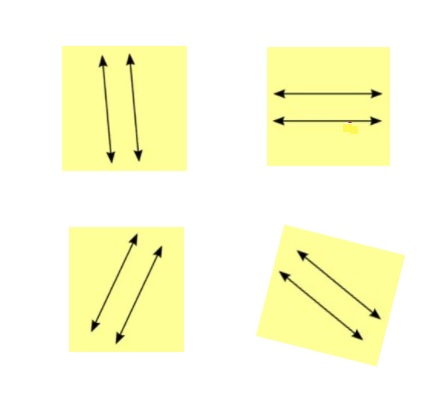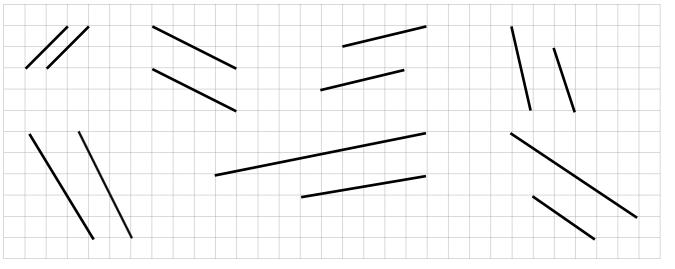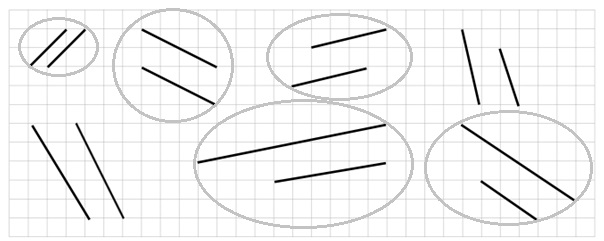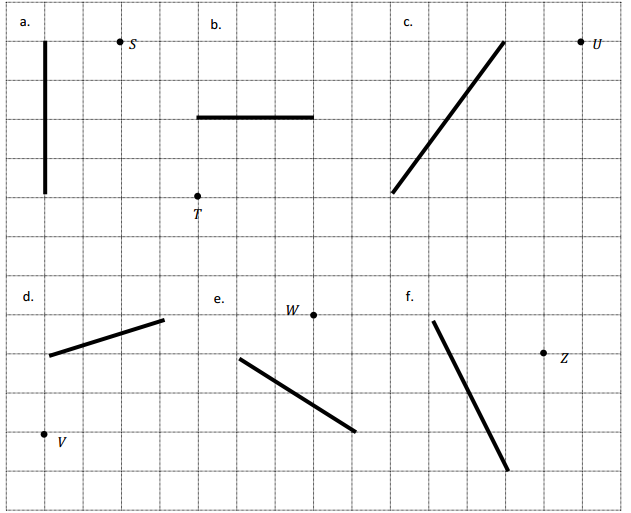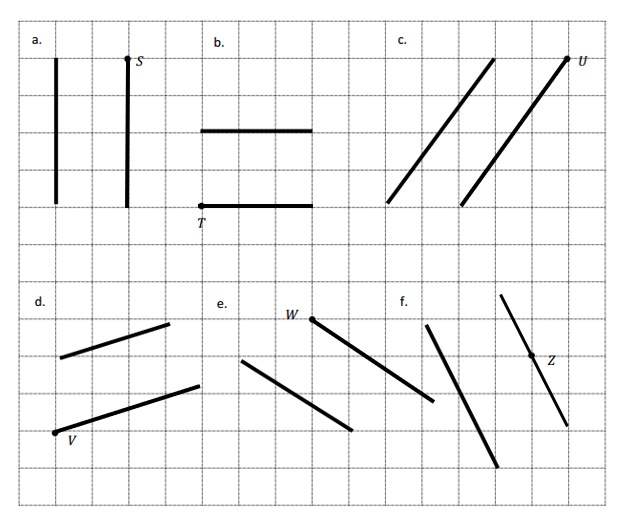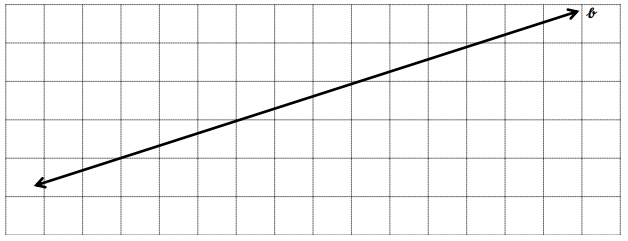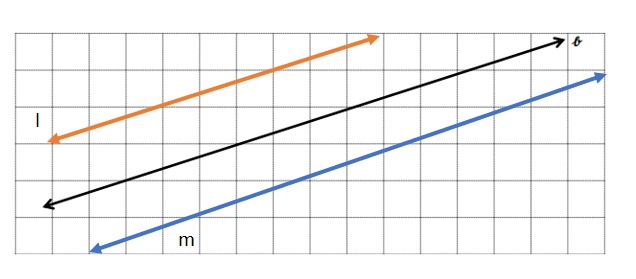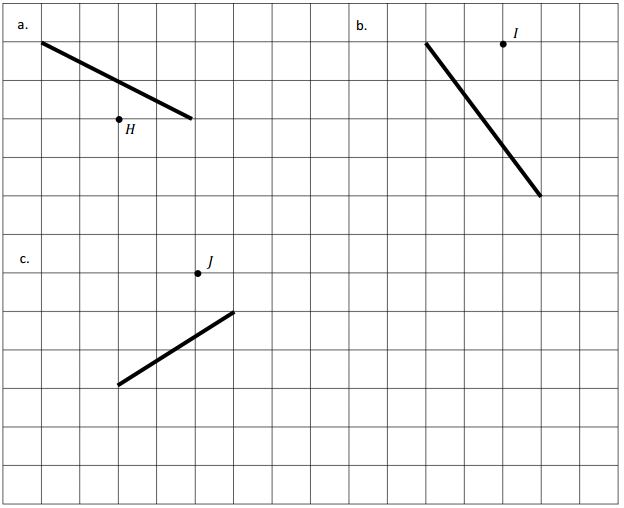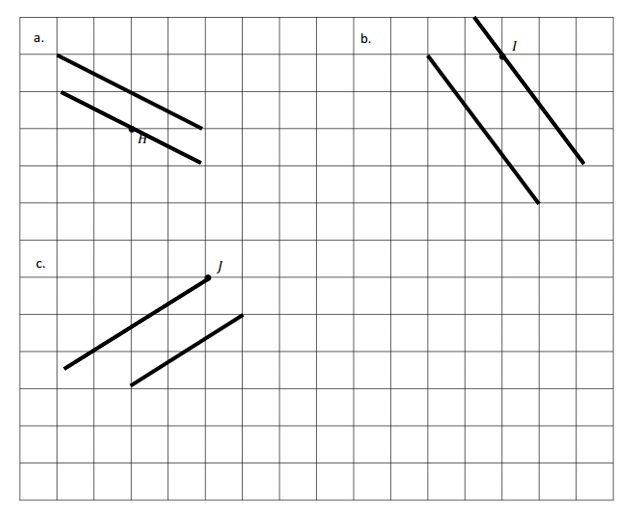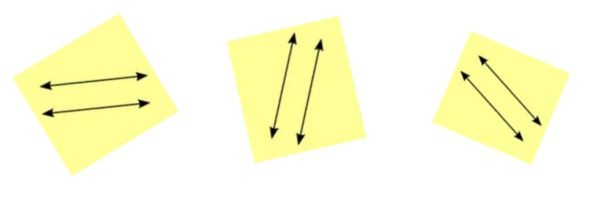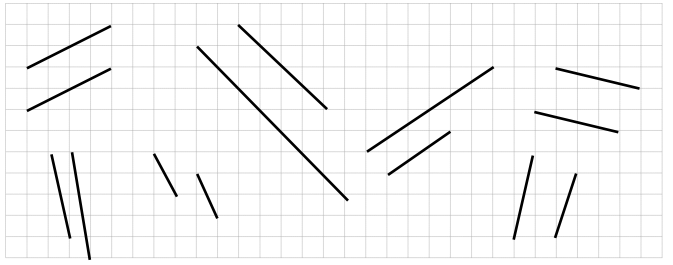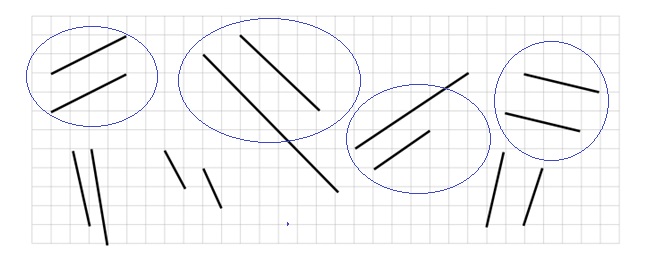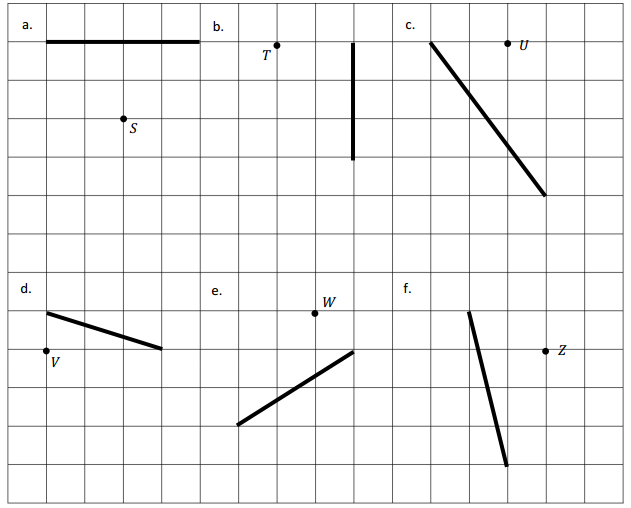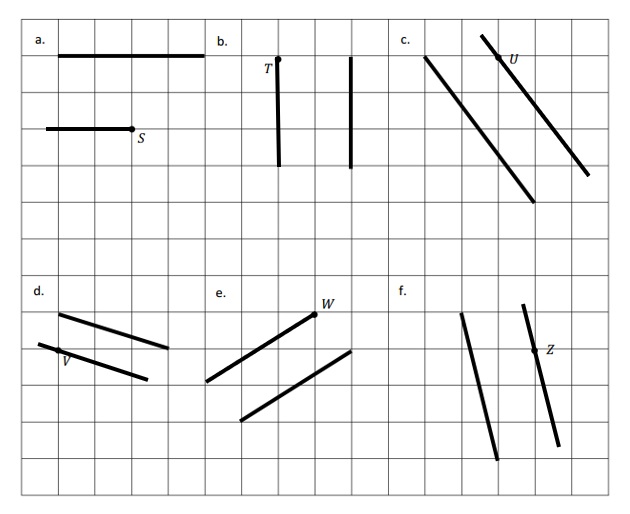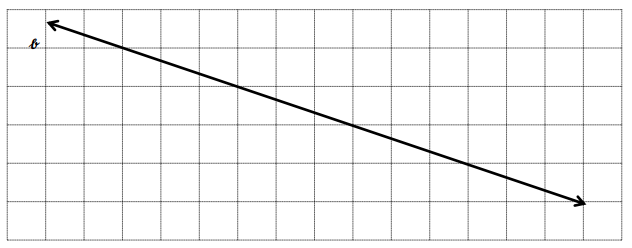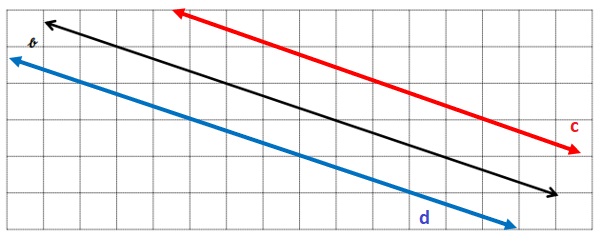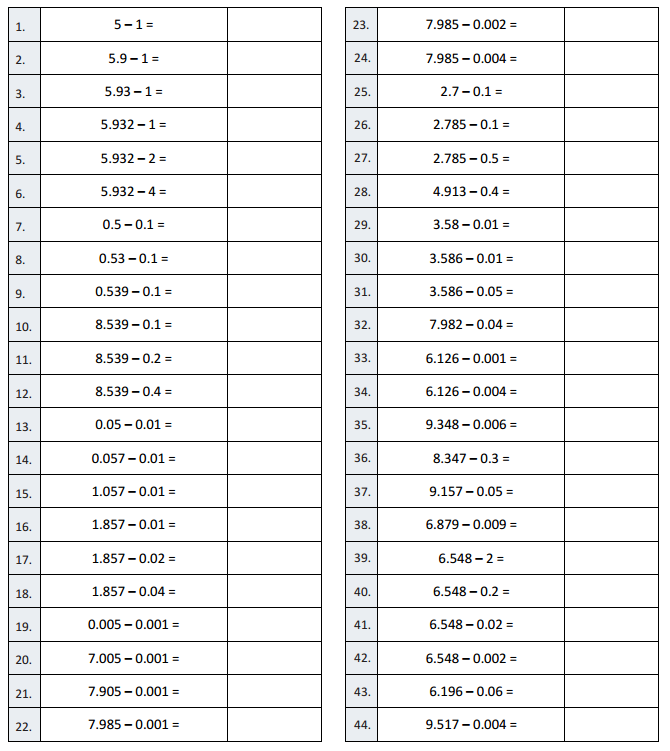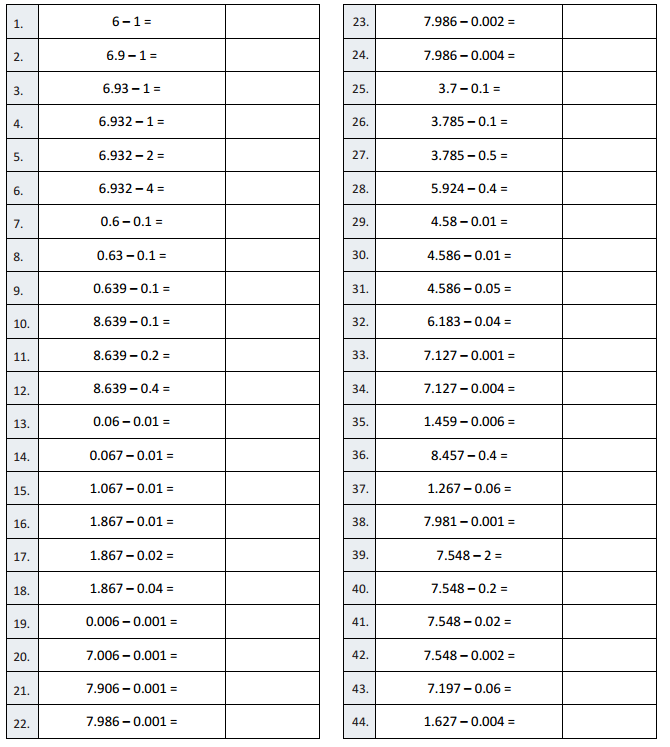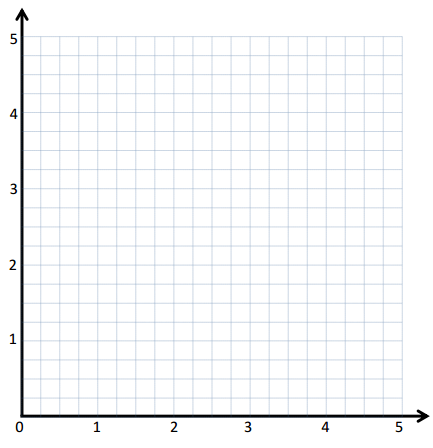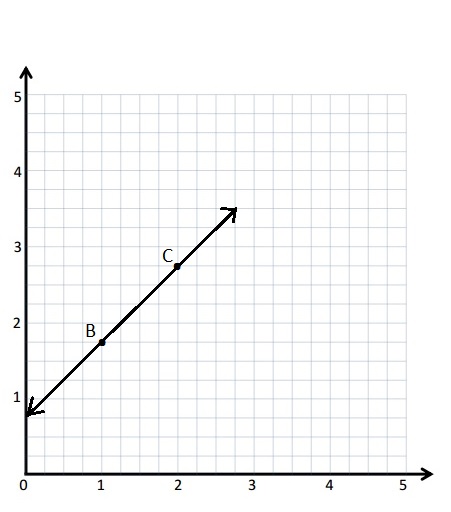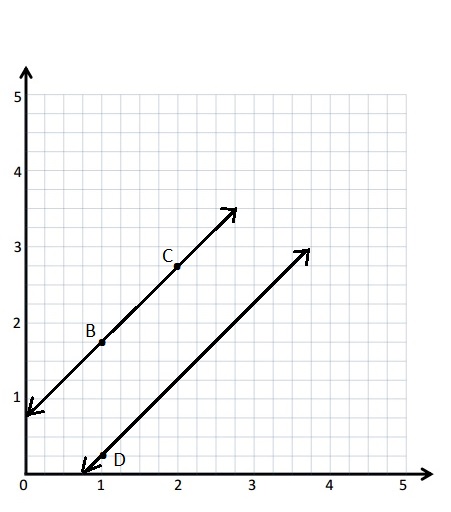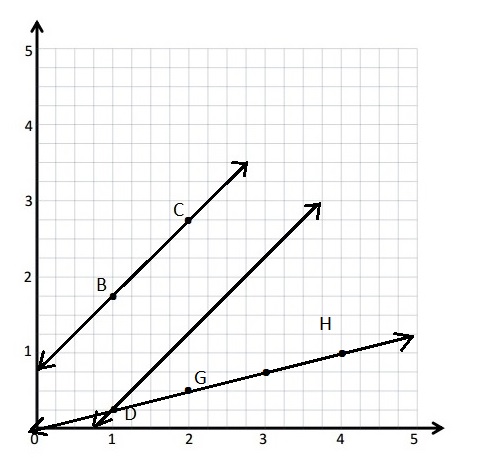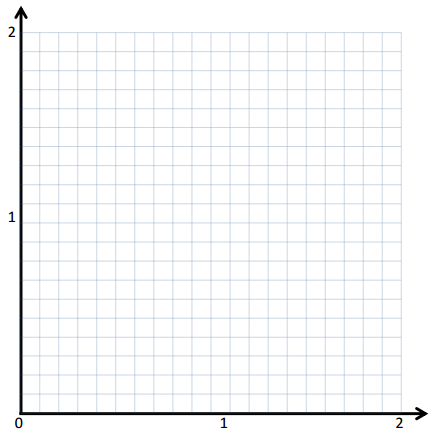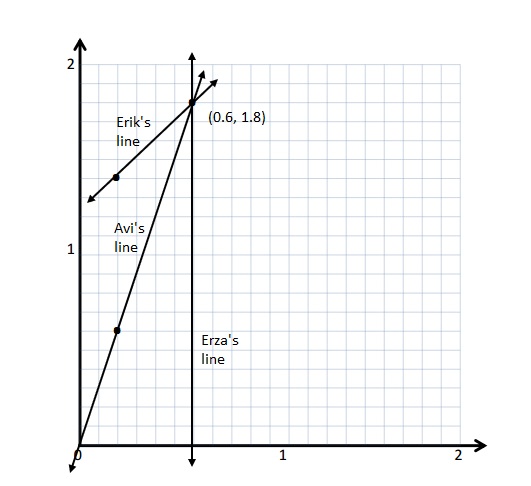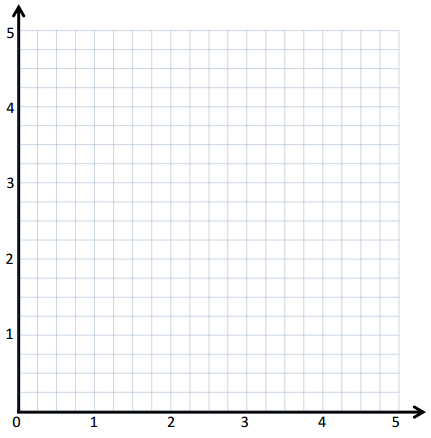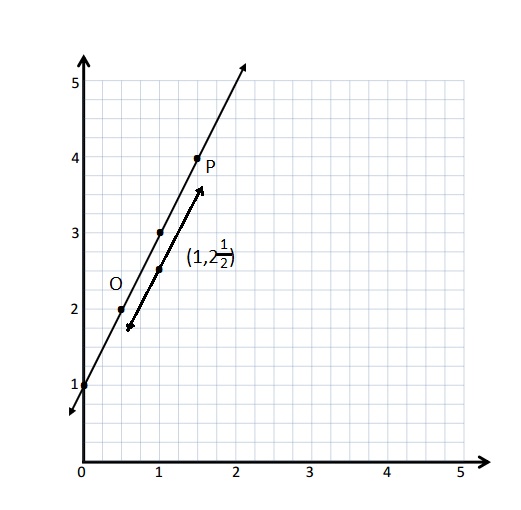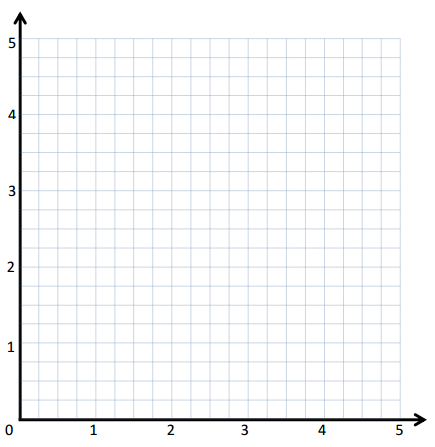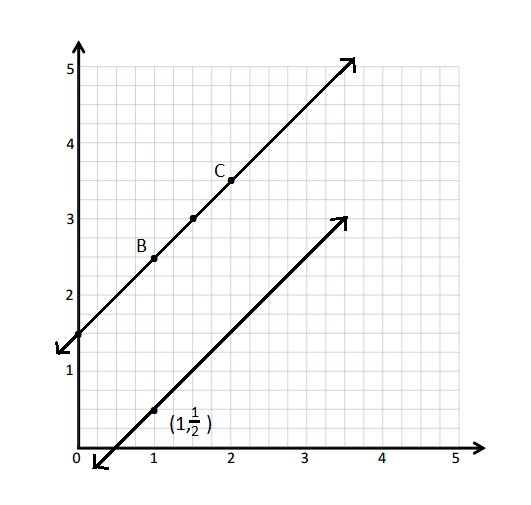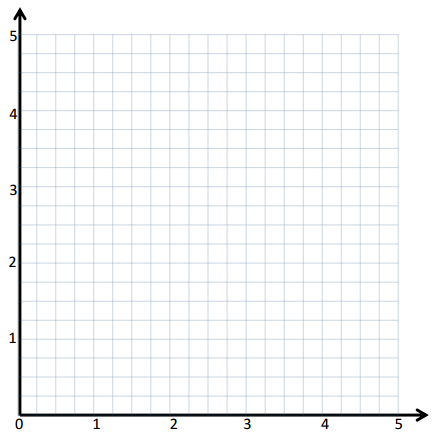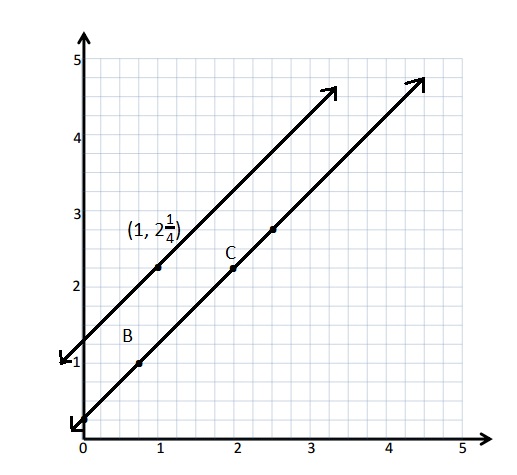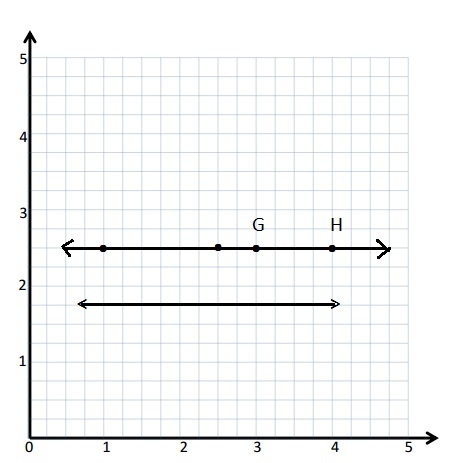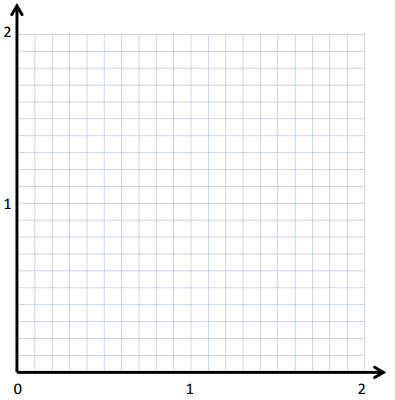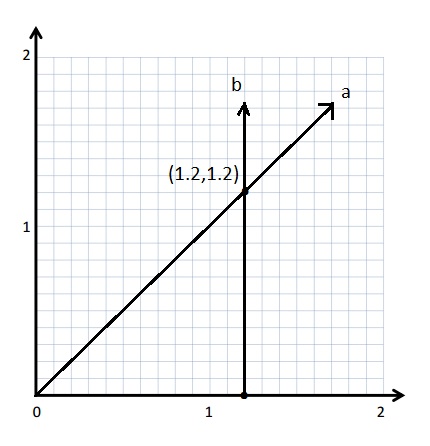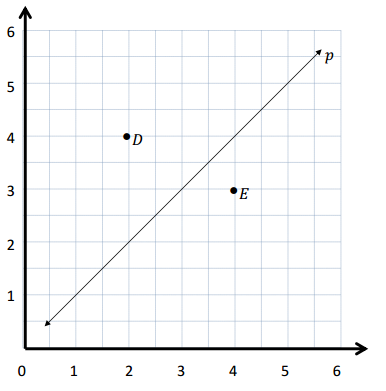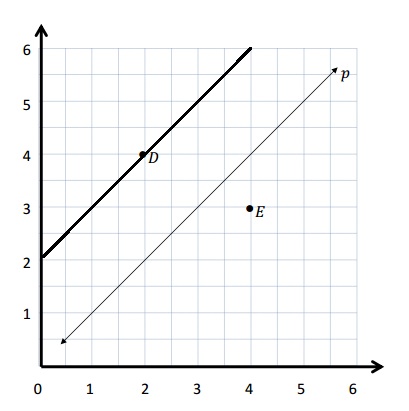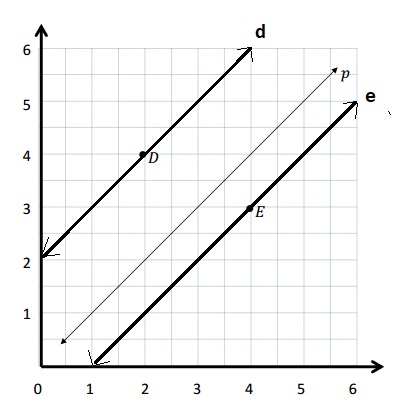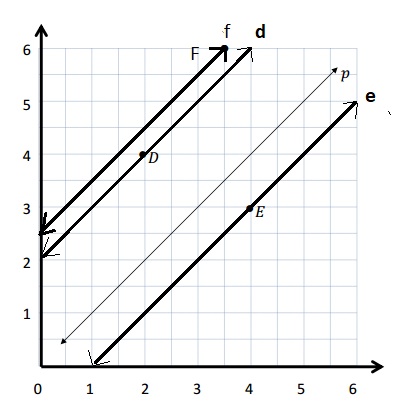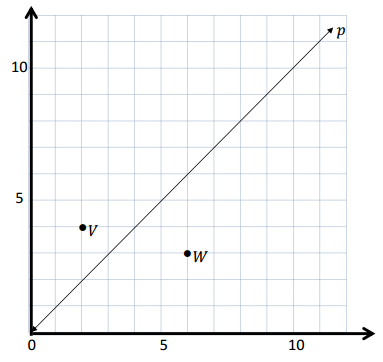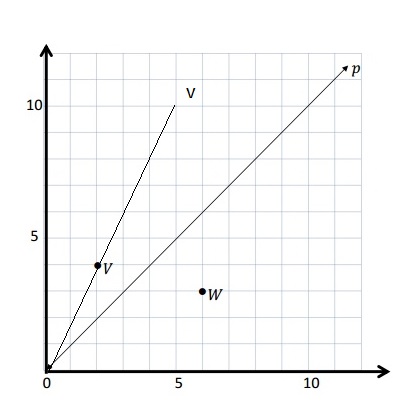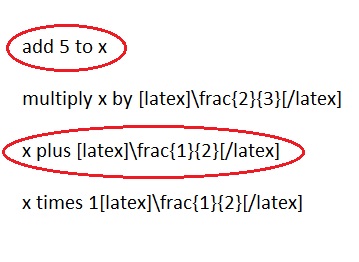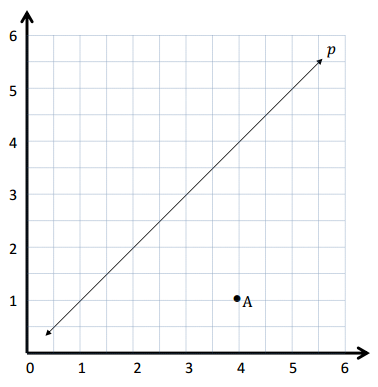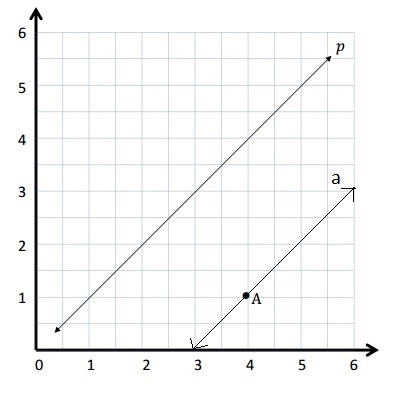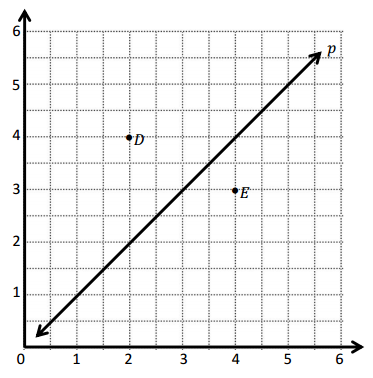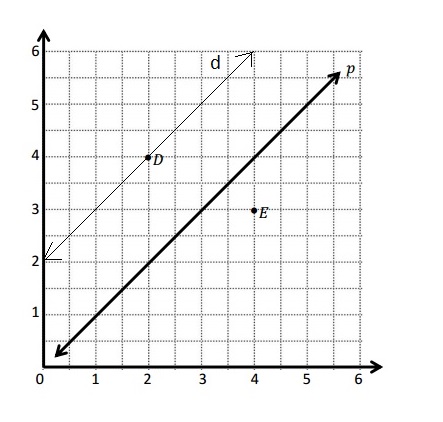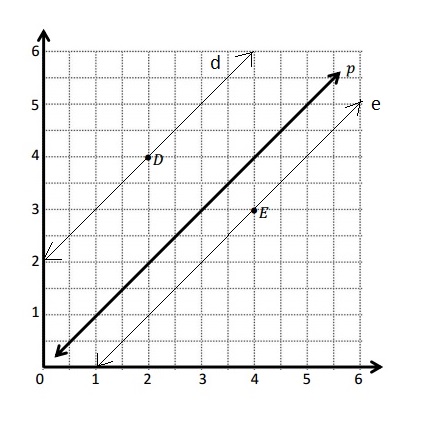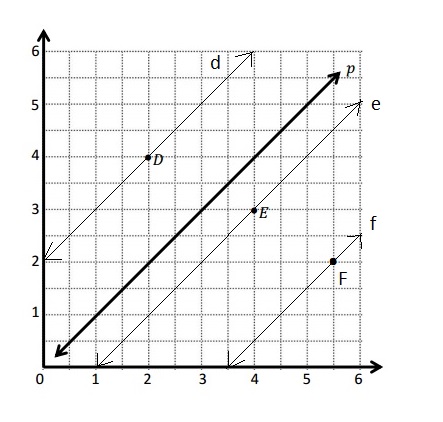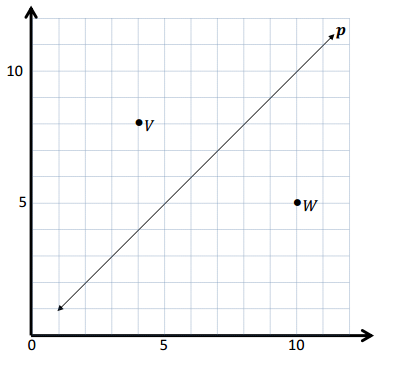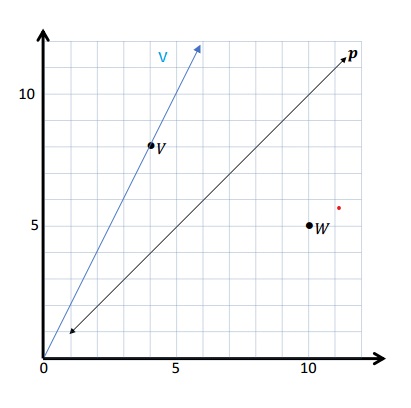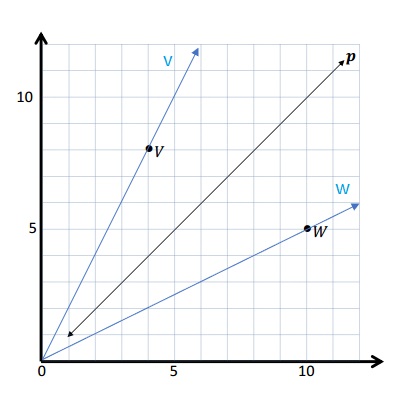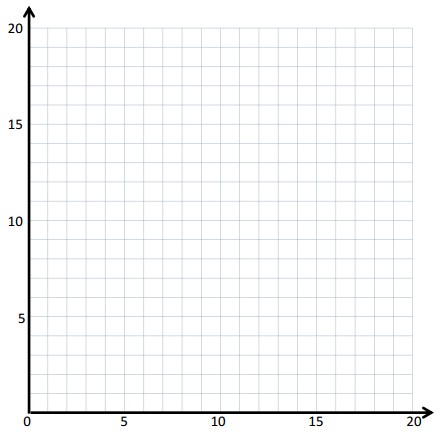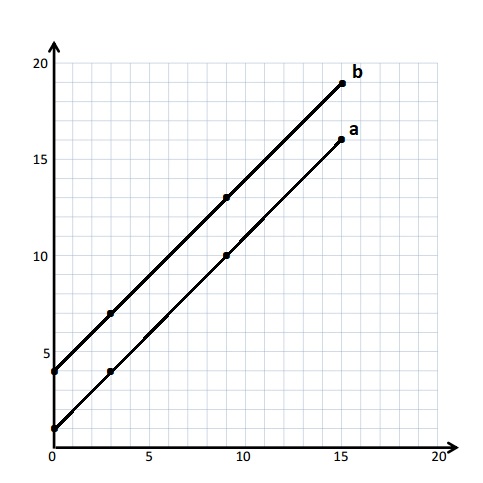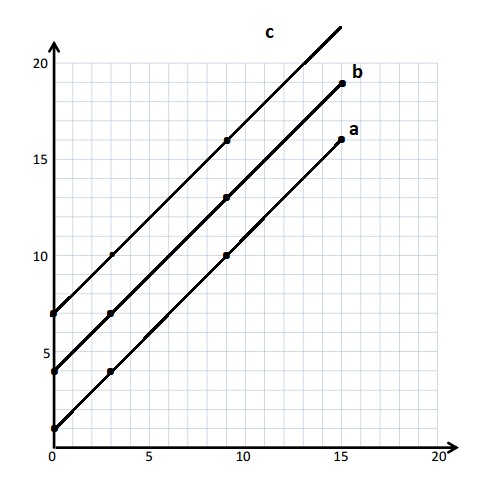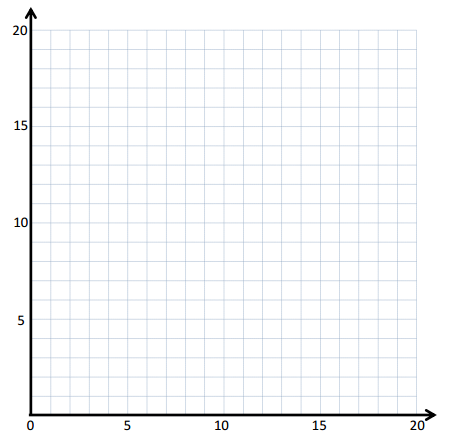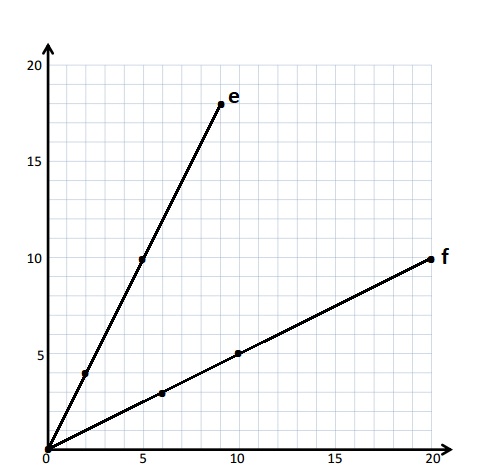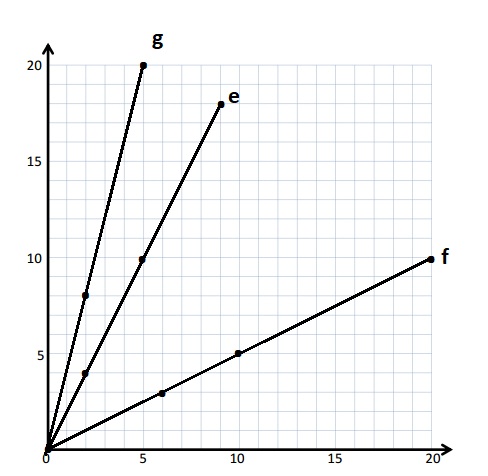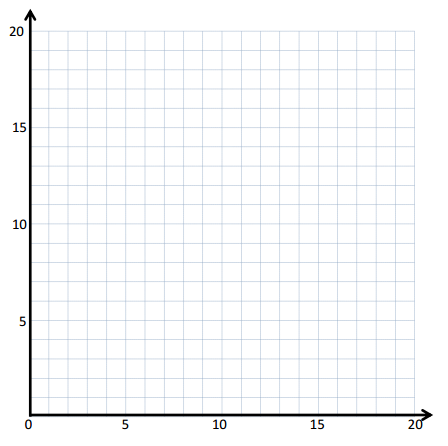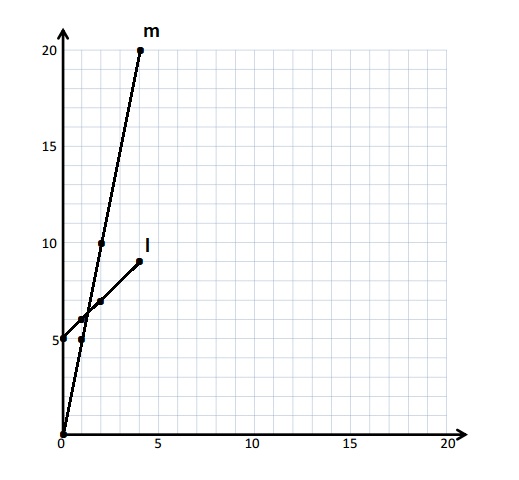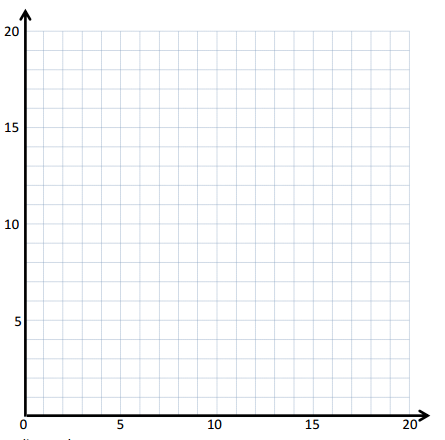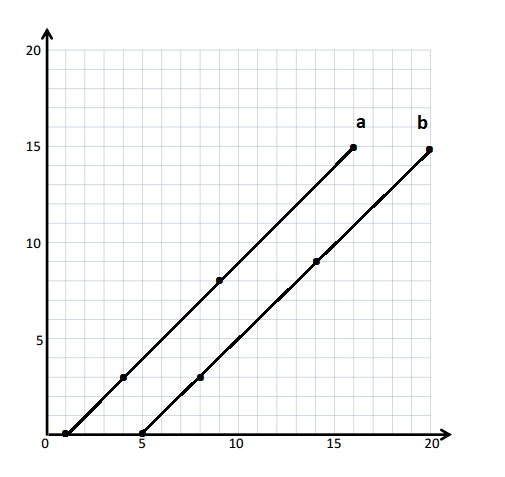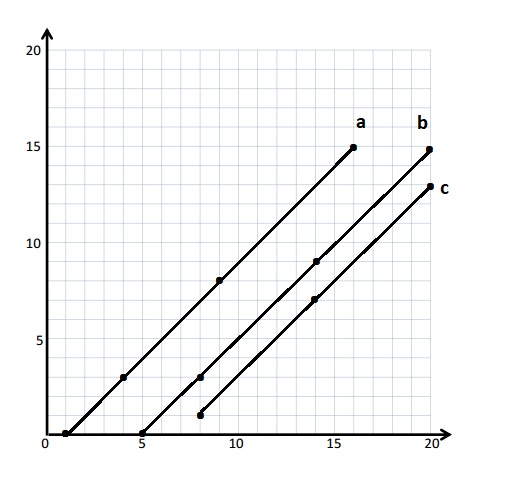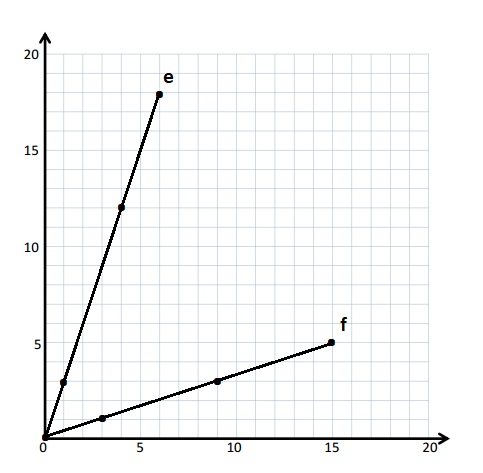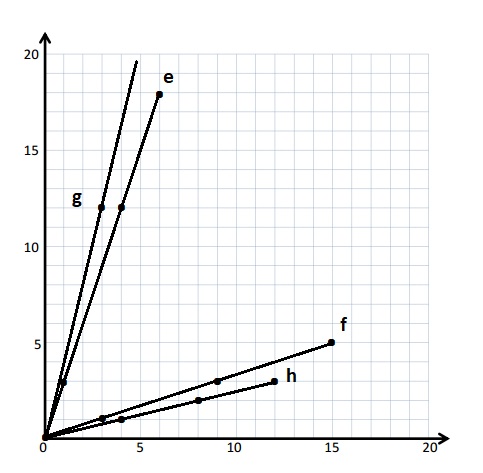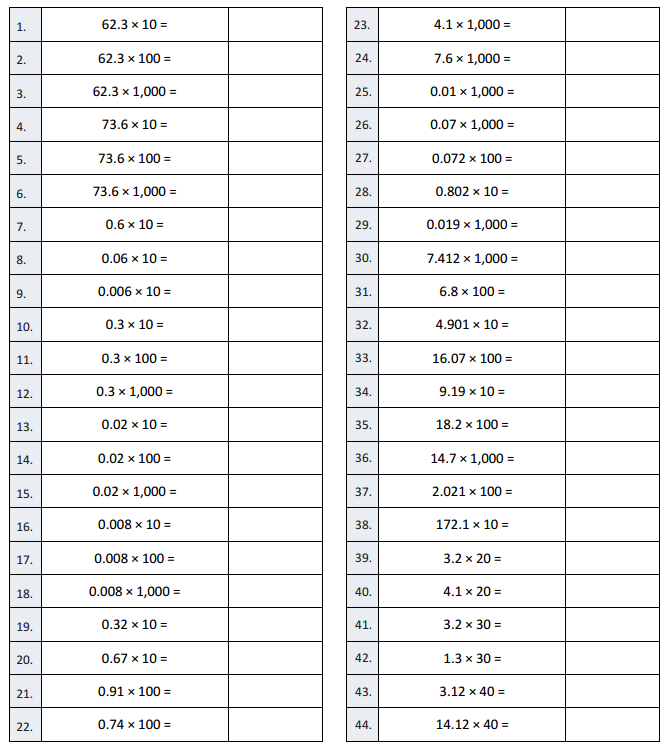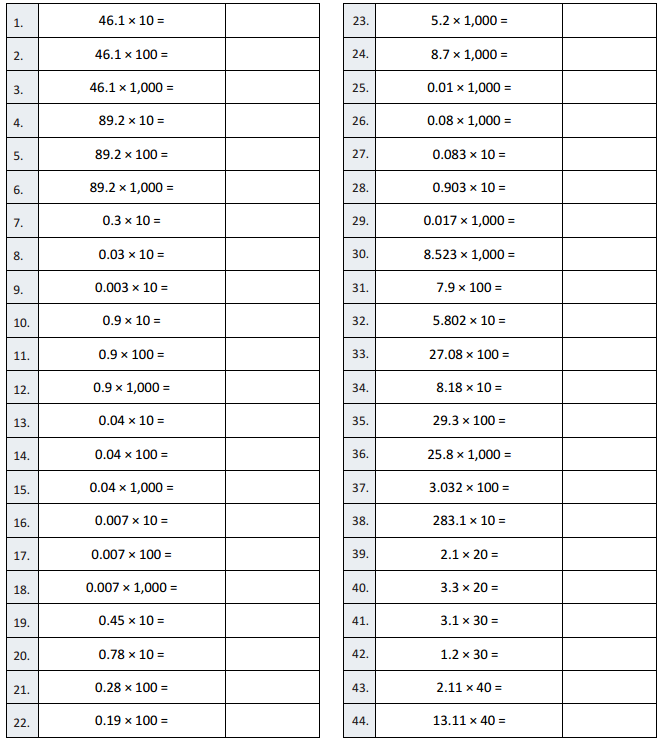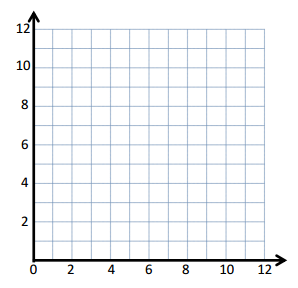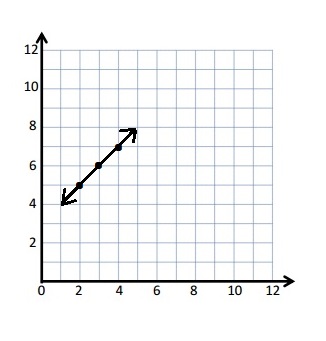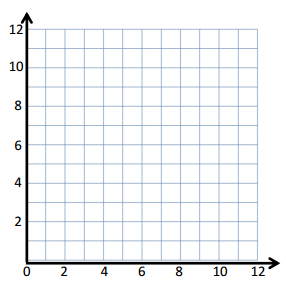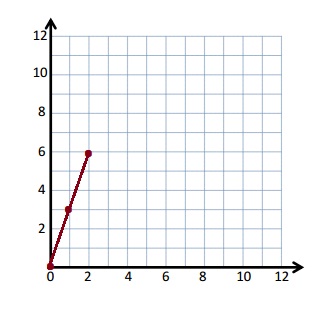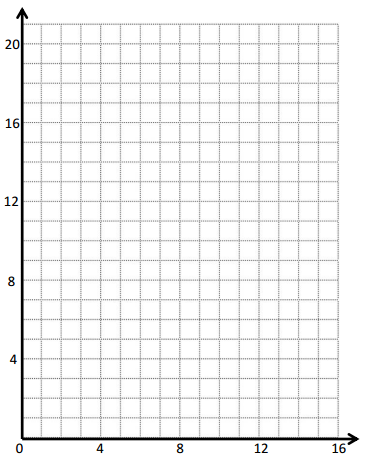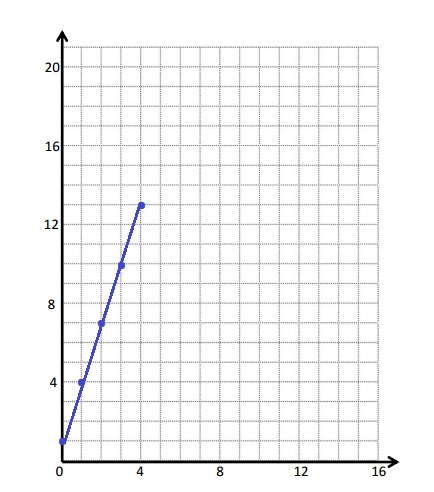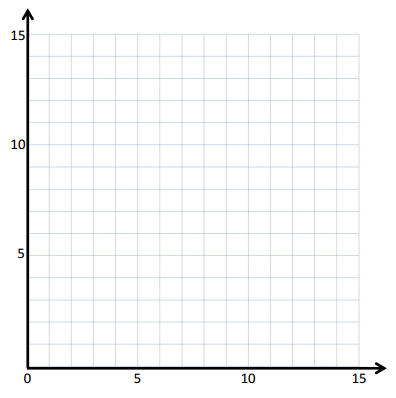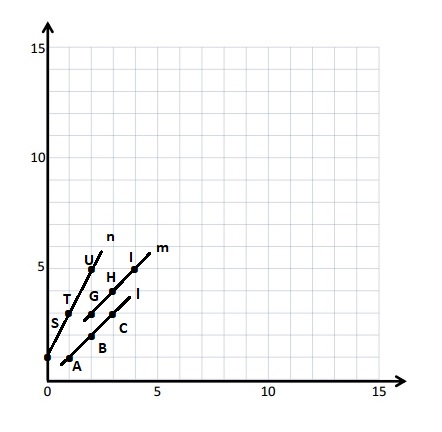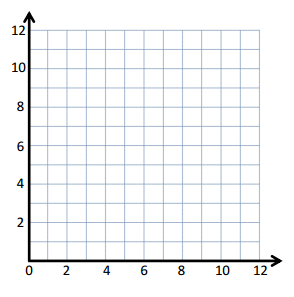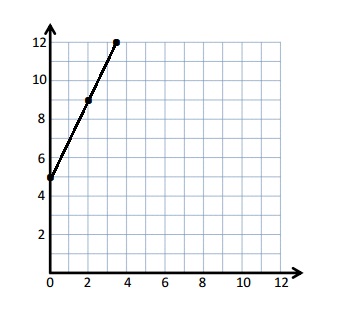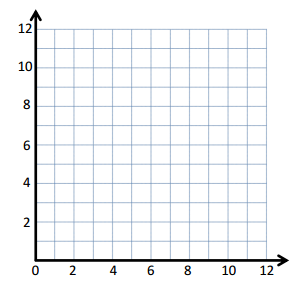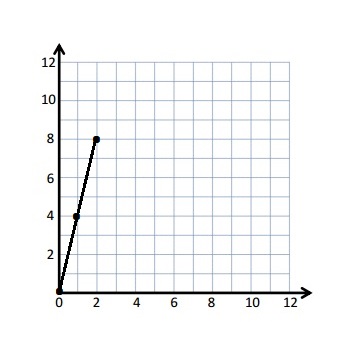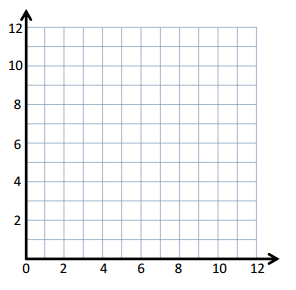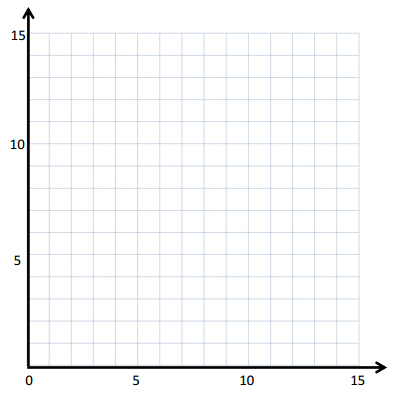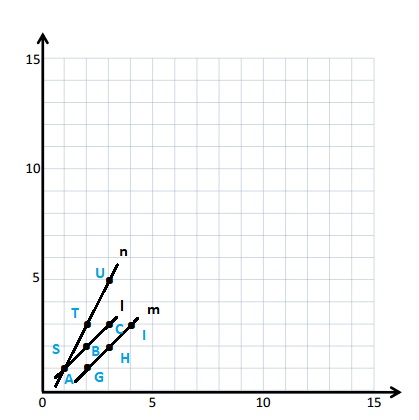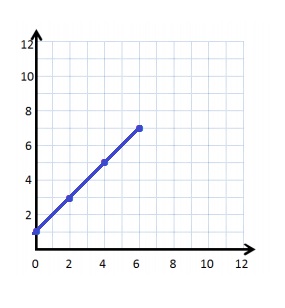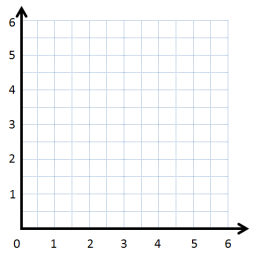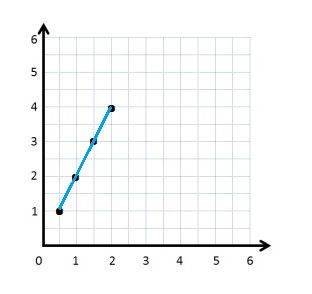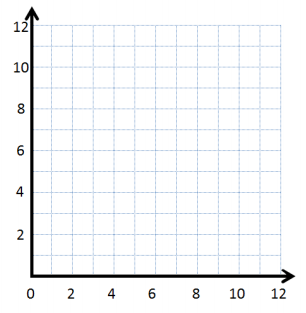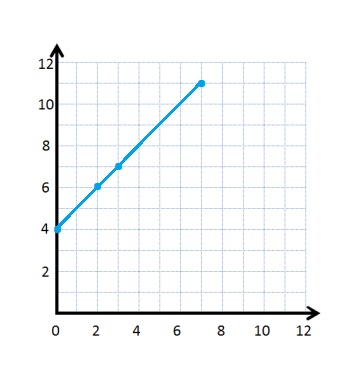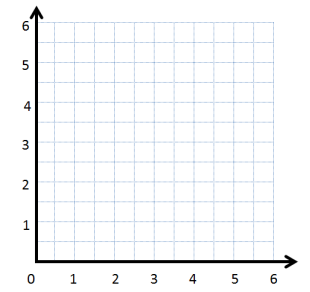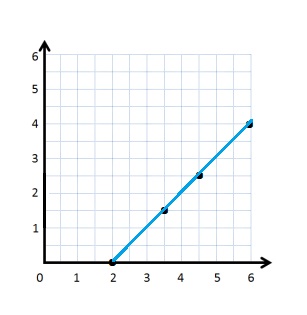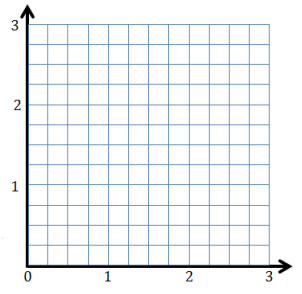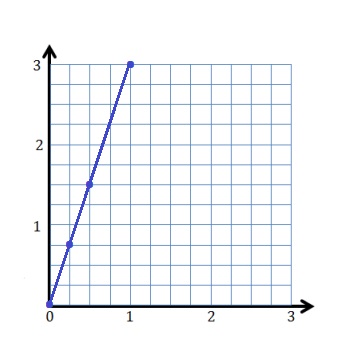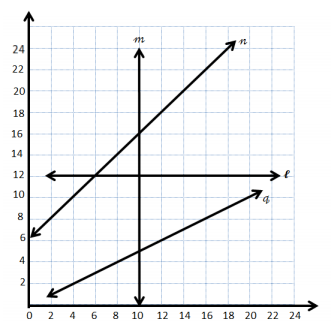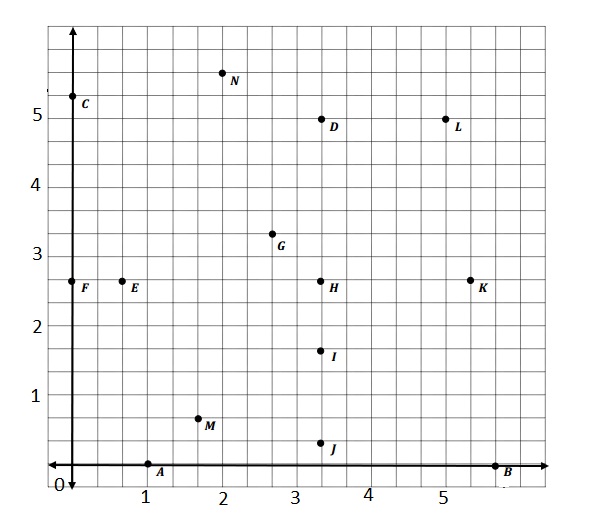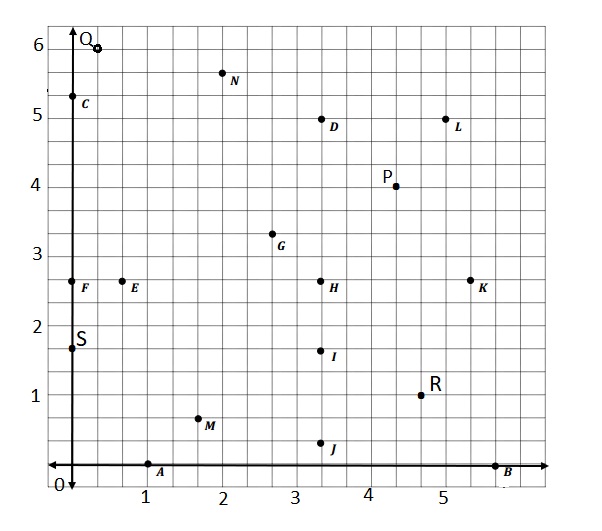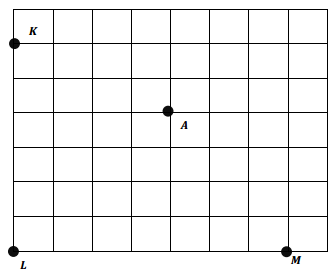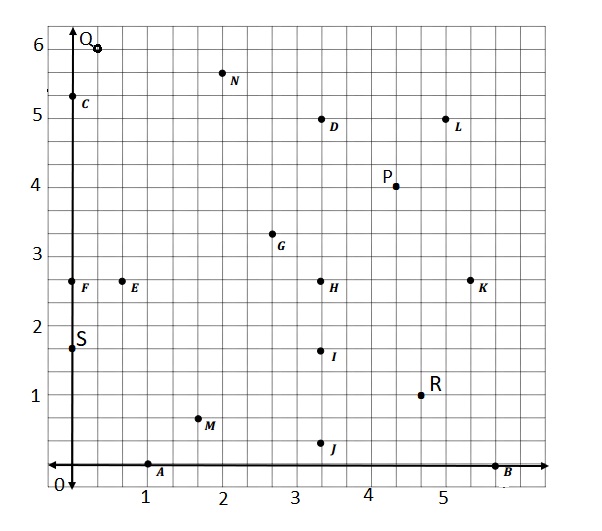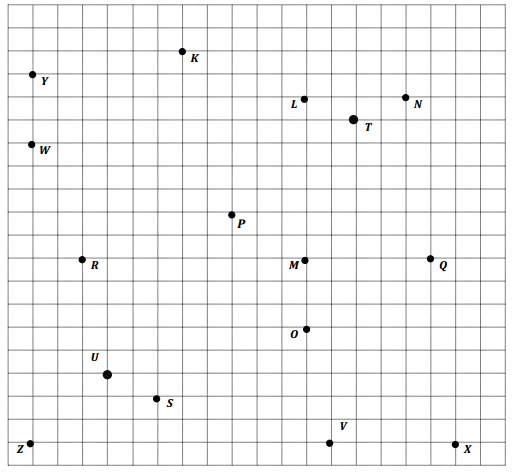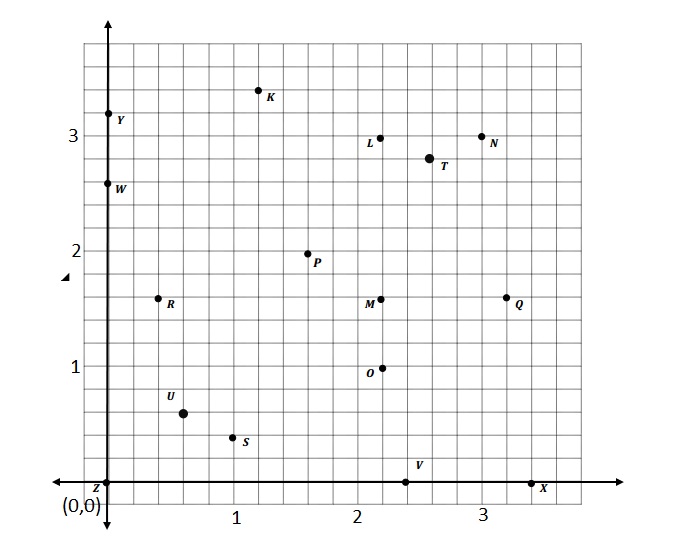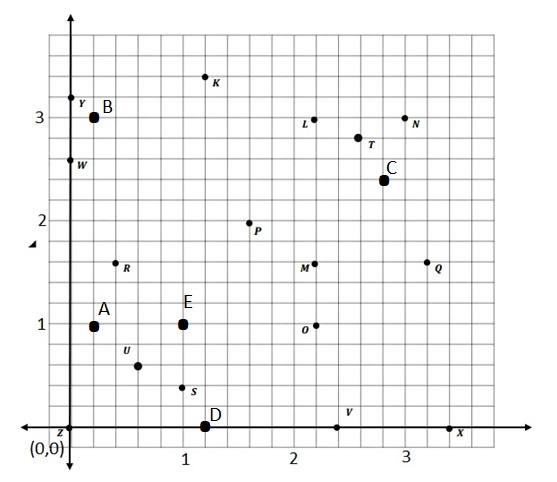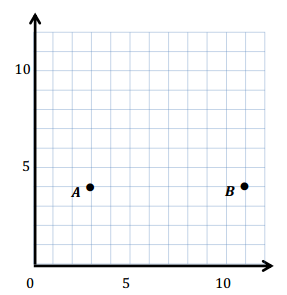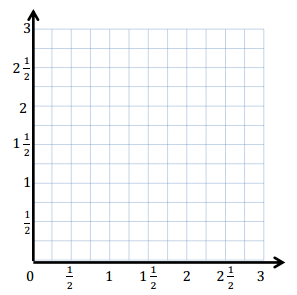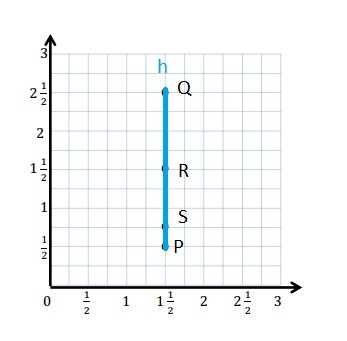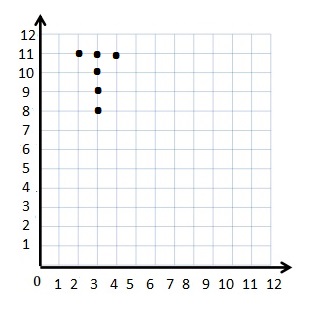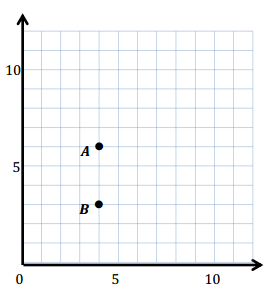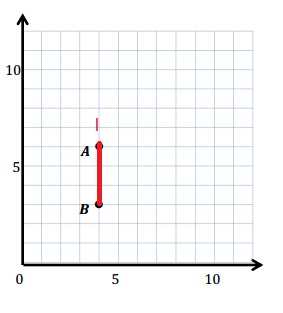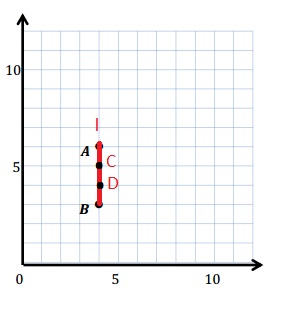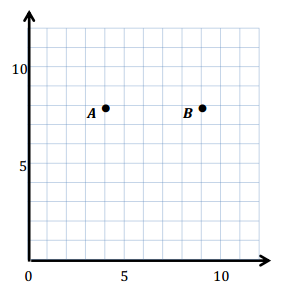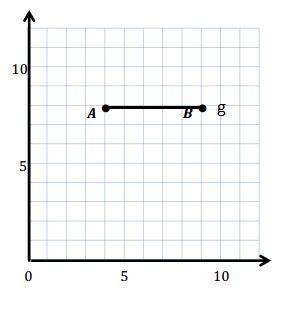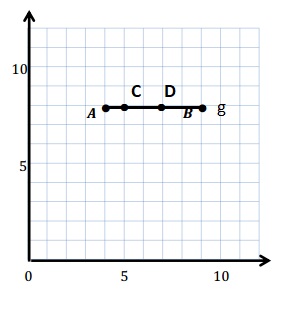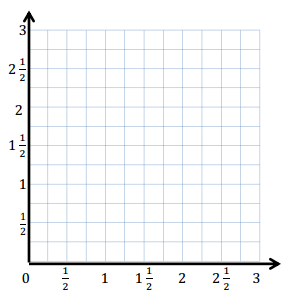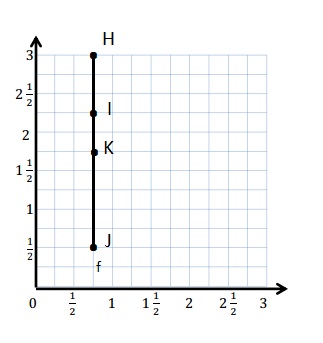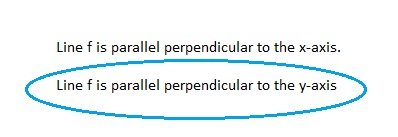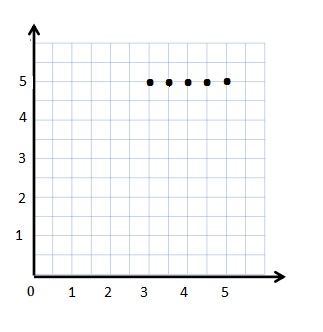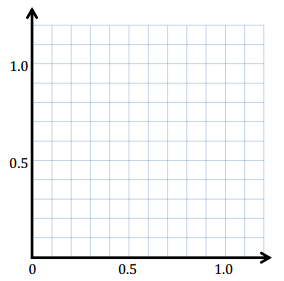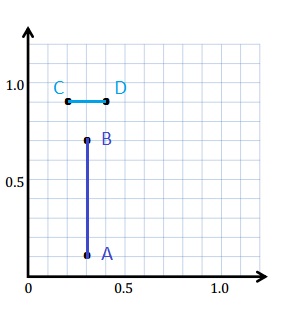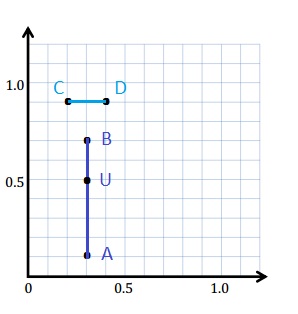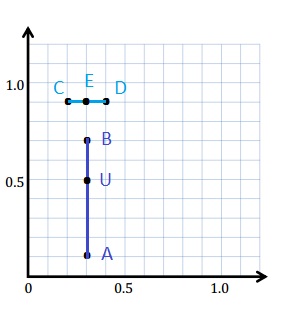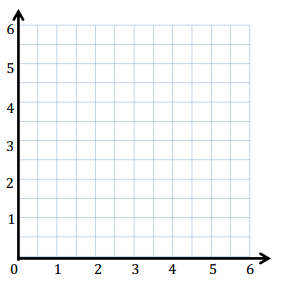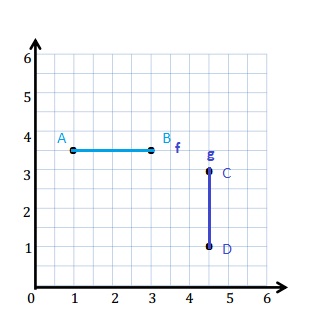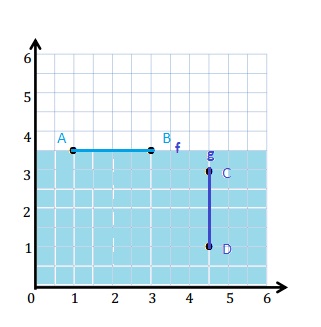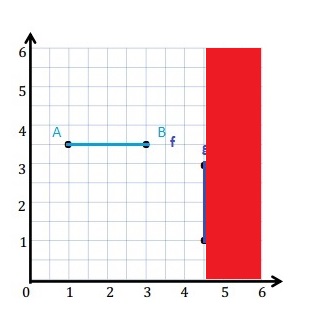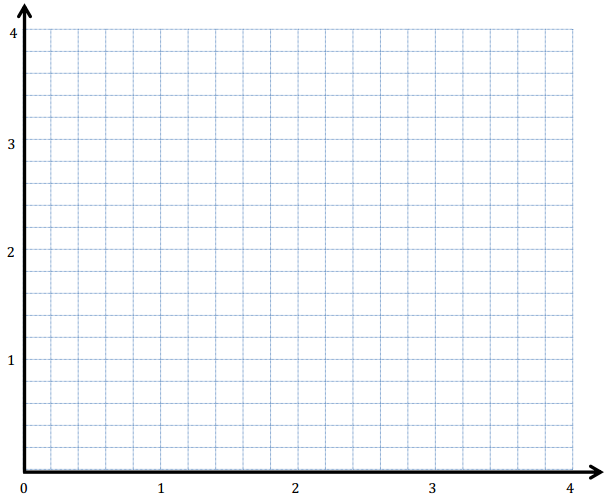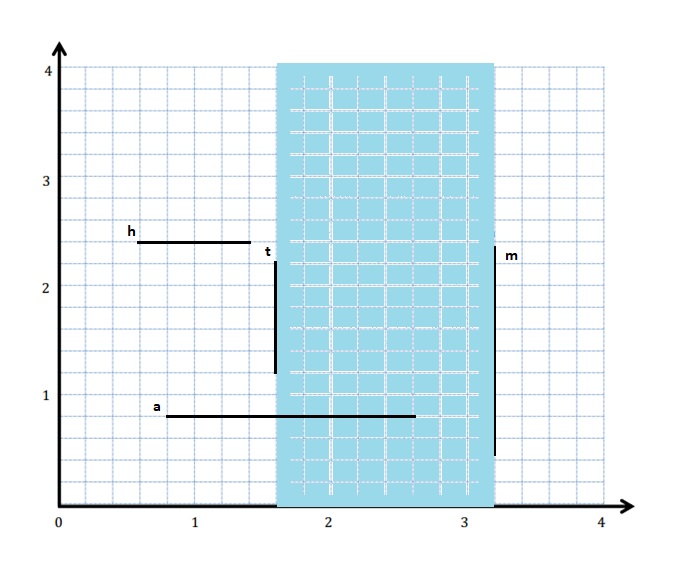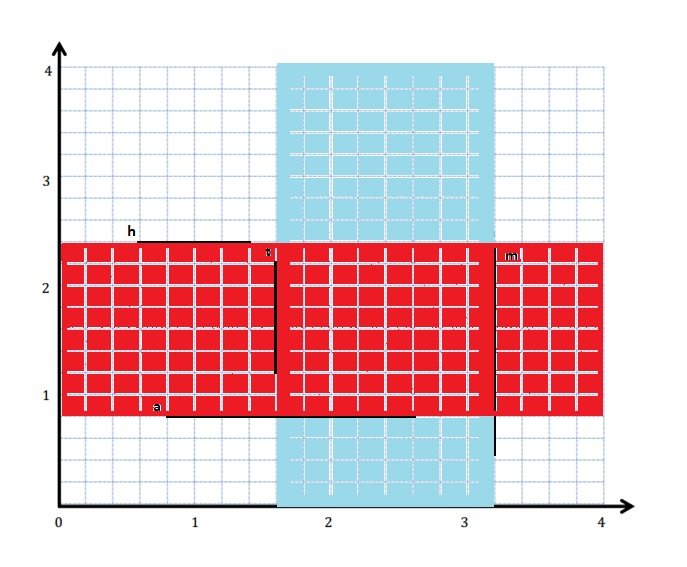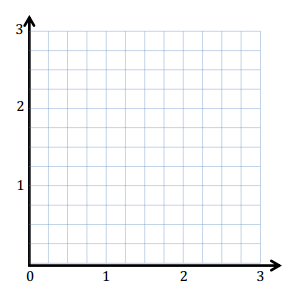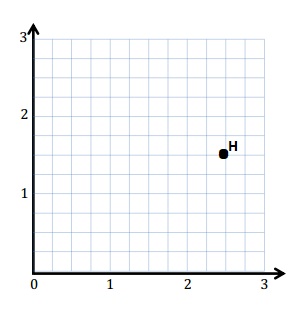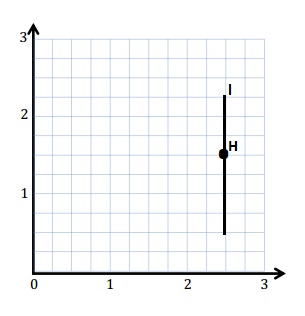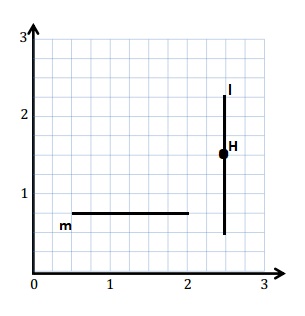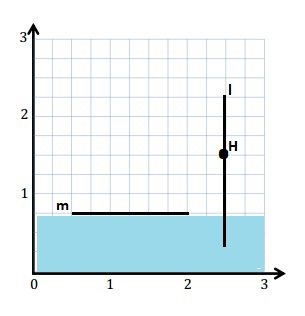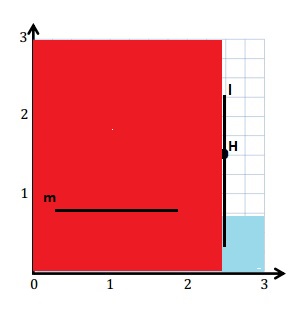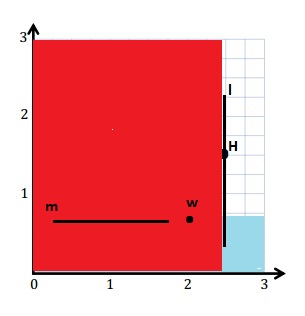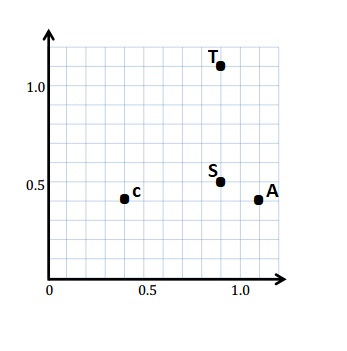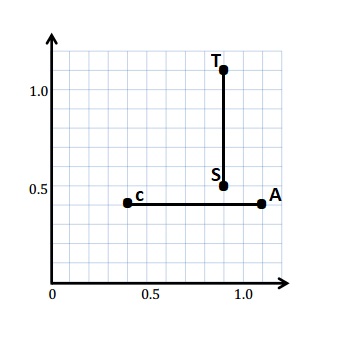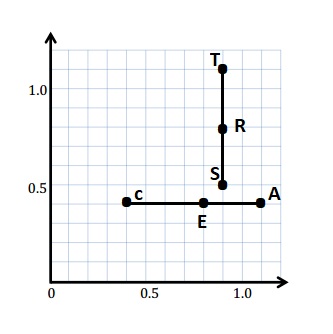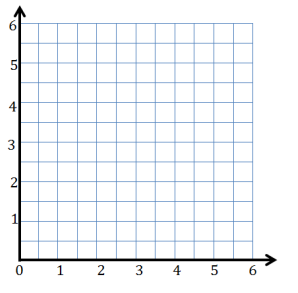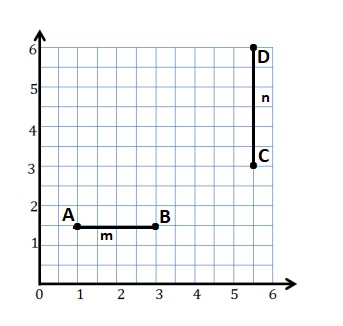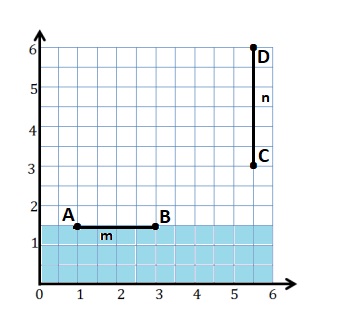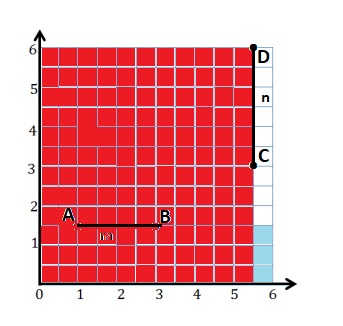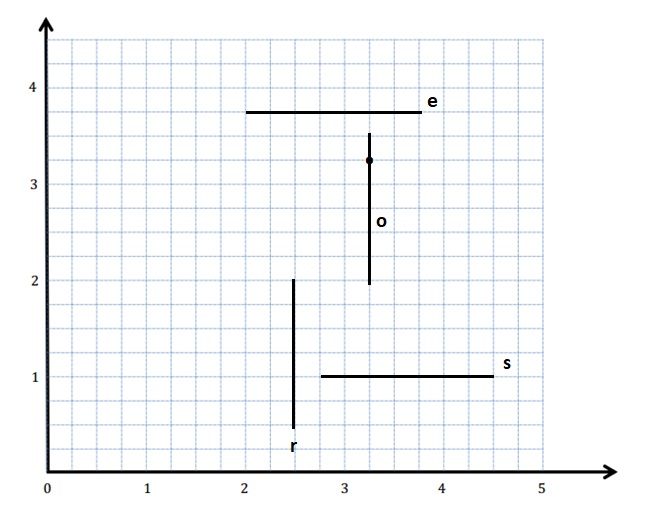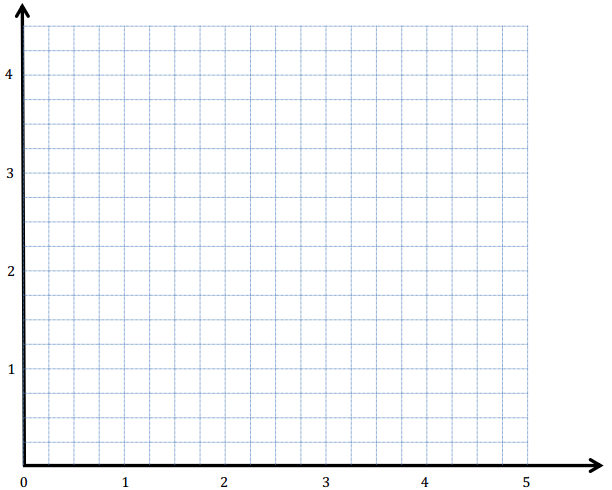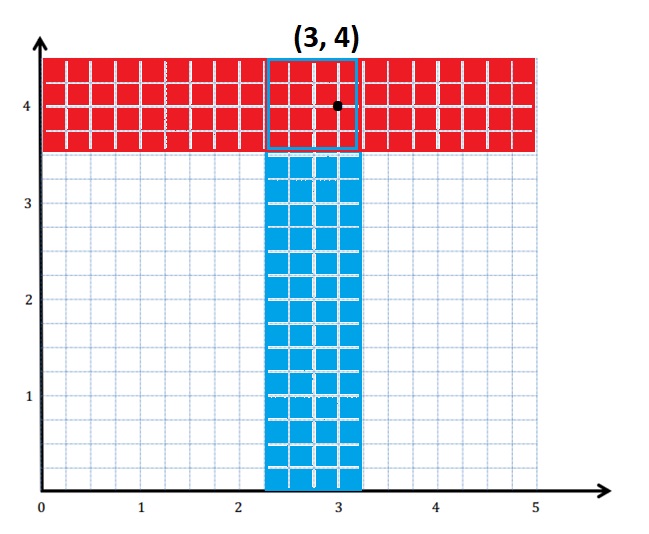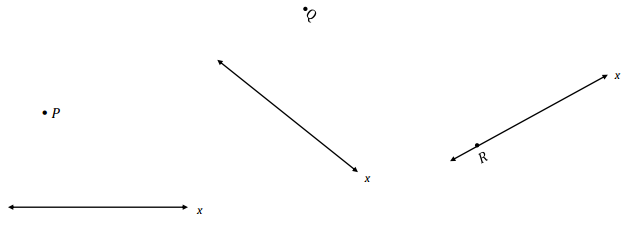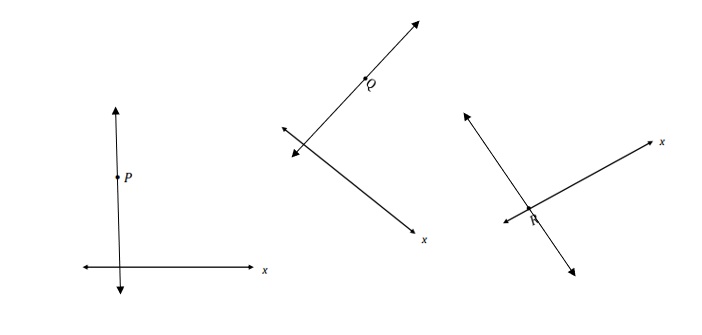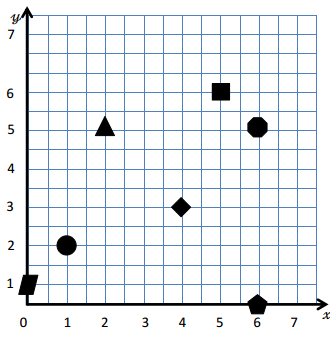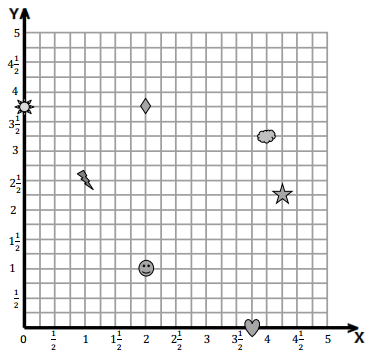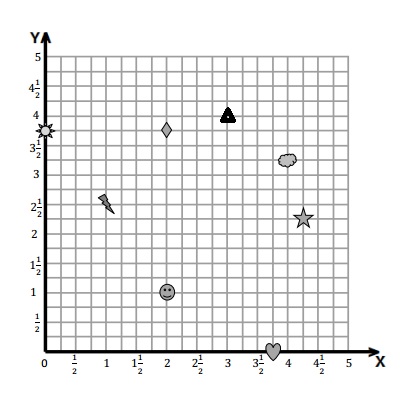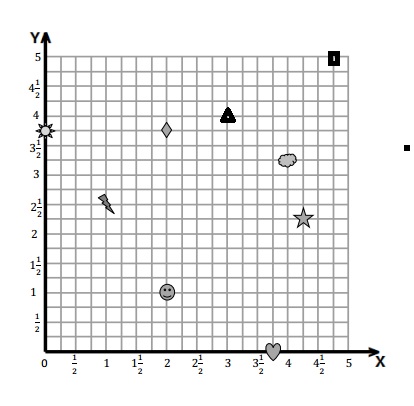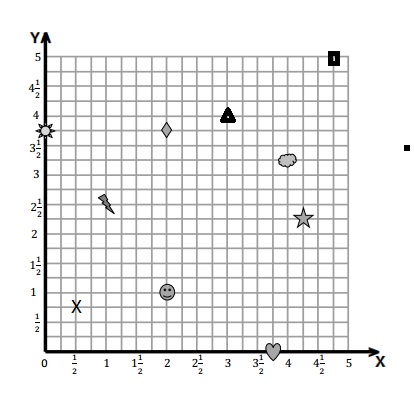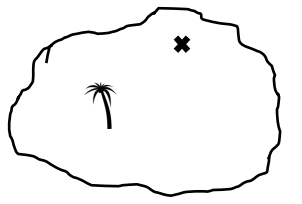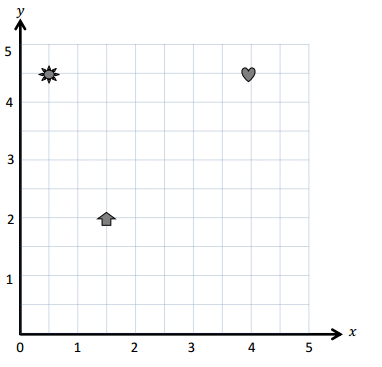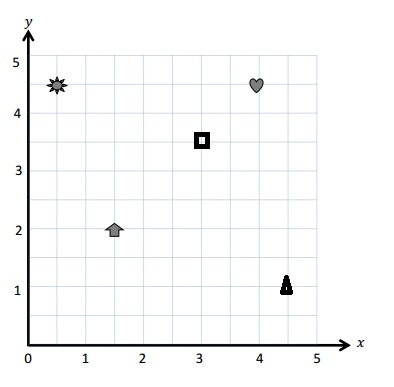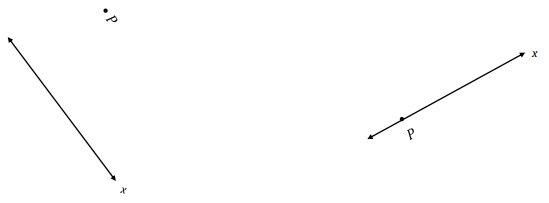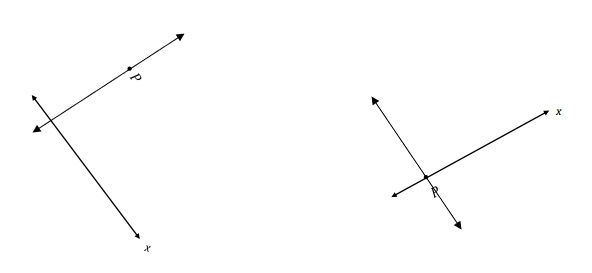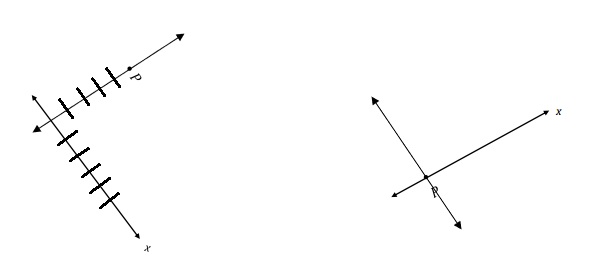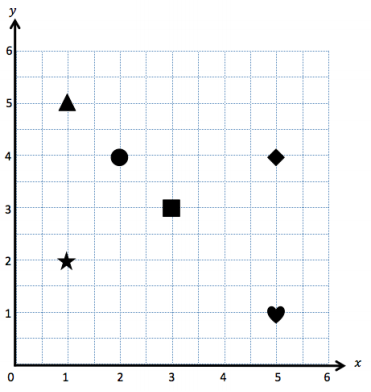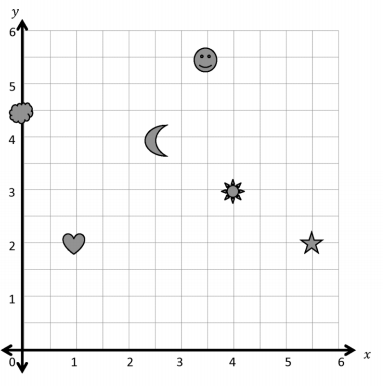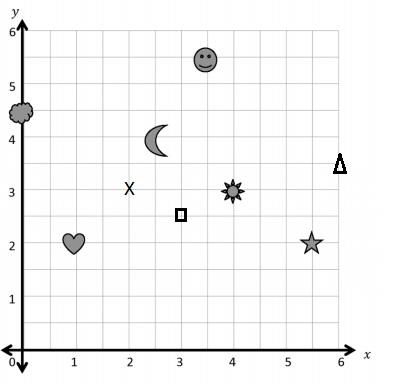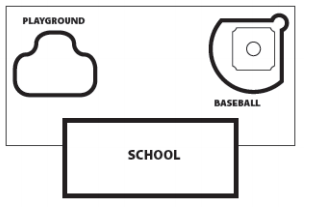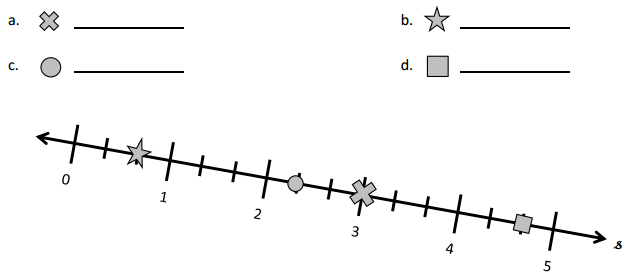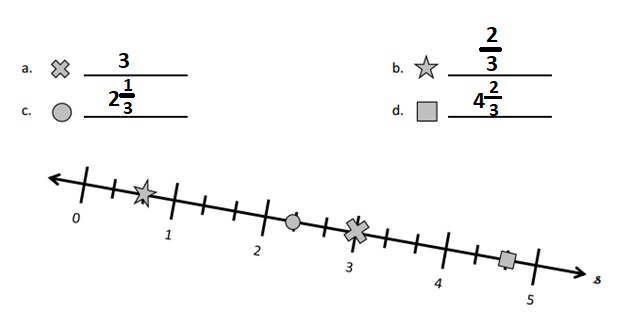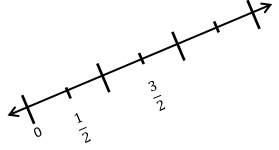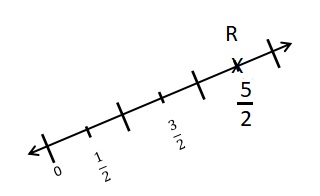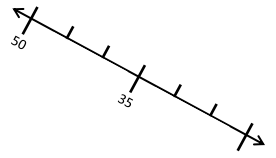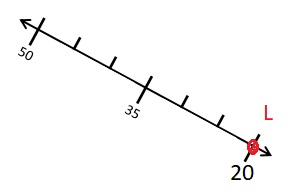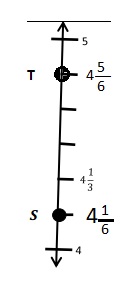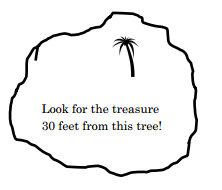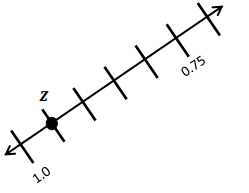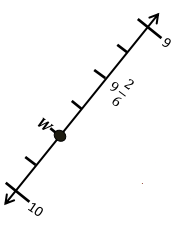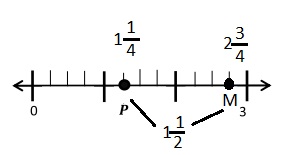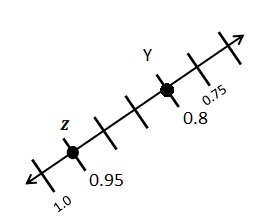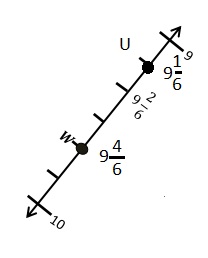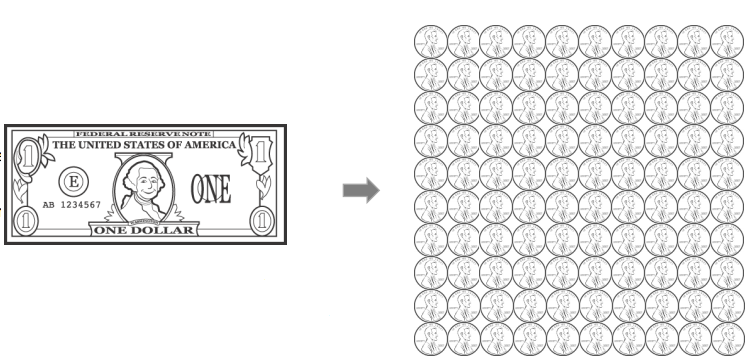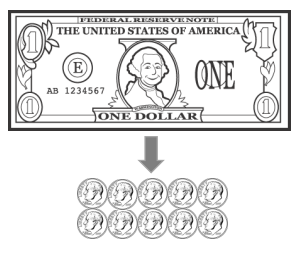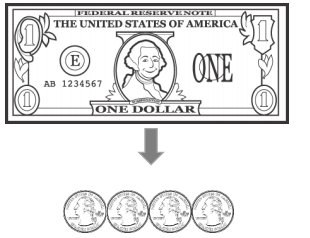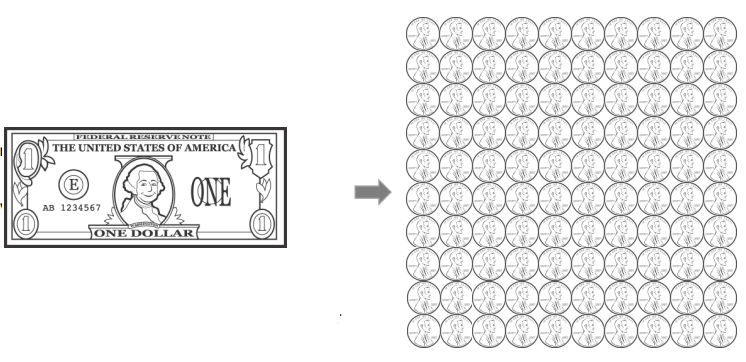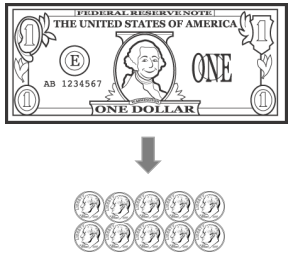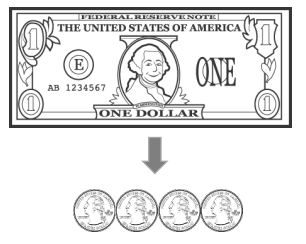Engage NY Eureka Math 4th Grade Module 3 Lesson 19 Answer Key
Eureka Math Grade 4 Module 3 Lesson 19 Sprint Answer Key
Mental Division
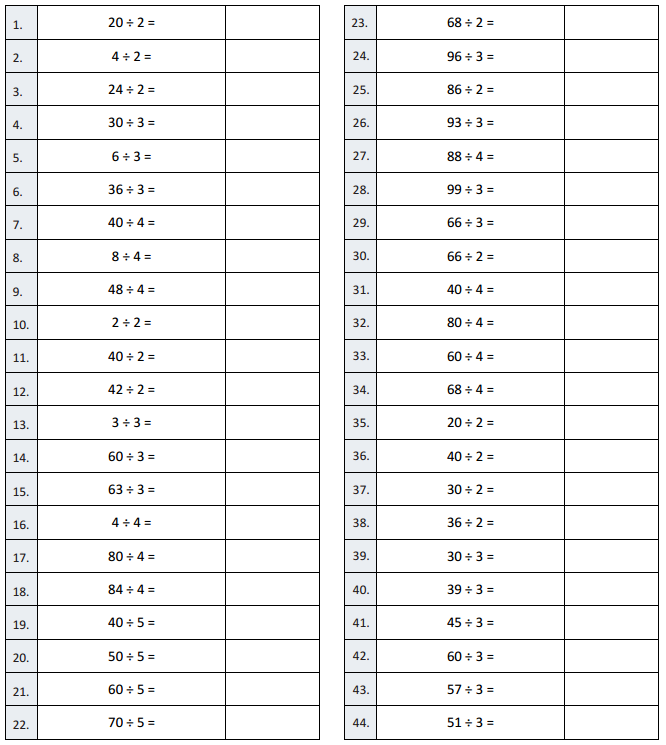
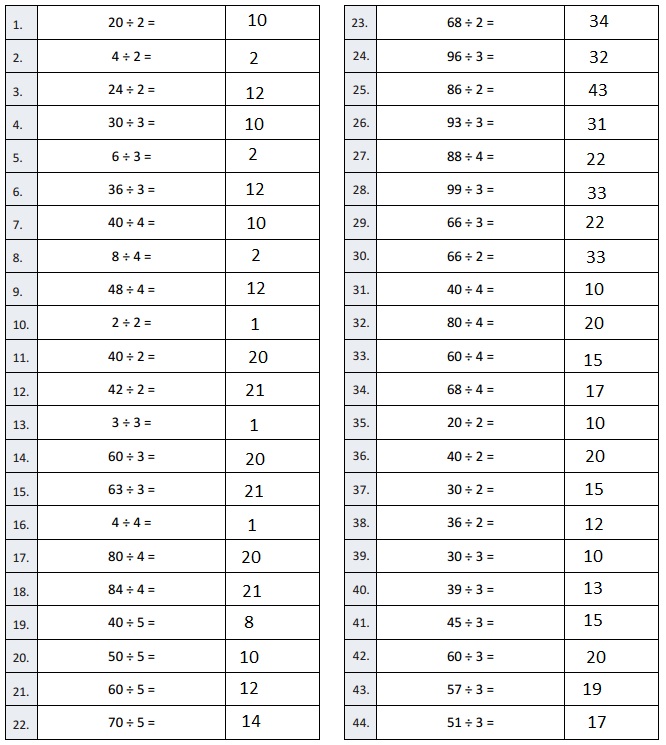
Question 1.
20 ÷ 2 =
Answer:
20 ÷ 2 = 10,
Explanation :
Given expression 20 ÷ 2 when 20 is divided by 2
we get 10, So quotient is 10 and remainder is 0 and
(2 X 10 = 20).
Question 2.
4 ÷ 2 =
Answer:
4 ÷ 2 = 2,
Explanation :
Given expression 4 ÷ 2 when 4 is divided by 2
we get 2, So quotient is 2 and remainder is 0 and
(2 X 2 = 4).
Question 3.
24 ÷ 2 =
Answer:
24 ÷ 2 = 12,
Explanation :
Given expression 24 ÷ 2 when 24 is divided by 2
we get 12, So quotient is 12 and remainder is 0 and
(2 X 12 = 24).
Question 4.
30 ÷ 3 =
Answer:
30 ÷ 3 = 10,
Explanation :
Given expression 30 ÷ 3 when 30 is divided by 3
we get 10, So quotient is 10 and remainder is 0 and
(3 X 10 = 30).
Question 5.
6 ÷ 3 =
Answer:
6 ÷ 3 = 2,
Explanation :
Given expression 6 ÷ 3 when 6 is divided by 3
we get 2, So quotient is 2 and remainder is 0 and
(3 X 2 = 6).
Question 6.
36 ÷ 3 =
Answer:
36 ÷ 3 = 12,
Explanation :
Given expression 36 ÷ 3 when 6 is divided by 3
we get 12, So quotient is 12 and remainder is 0 and
(3 X 12 = 36).
Question 7.
40 ÷ 4 =
Answer:
40 ÷ 4 = 10,
Explanation :
Given expression 40 ÷ 4 when 40 is divided by 4
we get 10, So quotient is 10 and remainder is 0 and
(4 X 10 = 40).
Question 8.
8 ÷ 4 =
Answer:
8 ÷ 4 = 2,
Explanation :
Given expression 40 ÷ 4 when 40 is divided by 4
we get 10, So quotient is 10 and remainder is 0 and
(4 X 10 = 40).
Question 9.
48 ÷ 4 =
Answer:
48 ÷ 4 = 12,
Explanation :
Given expression 48 ÷ 4 when 48 is divided by 4
we get 12, So quotient is 12 and remainder is 0 and
(4 X 12 = 46).
Question 10.
2 ÷ 2 =
Answer:
2 ÷ 2 = 1,
Explanation :
Given expression 2 ÷ 2 when 2 is divided by 2
we get 1, So quotient is 1 and remainder is 0 and
(2 X 1 = 2).
Question 11.
40 ÷ 2 =
Answer:
40 ÷ 2 = 20,
Explanation :
Given expression 40 ÷ 2 when 40 is divided by 2
we get 20, So quotient is 20 and remainder is 0 and
(2 X 20 = 40).
Question 12.
42 ÷ 2 =
Answer:
42 ÷ 2 = 21,
Explanation :
Given expression 42 ÷ 2 when 42 is divided by 2
we get 21, So quotient is 21 and remainder is 0 and
(2 X 21 = 42).
Question 13.
3 ÷ 3 =
Answer:
3 ÷ 3 = 1,
Explanation :
Given expression 3 ÷ 3 when 1 is divided by 3
we get 3, So quotient is 1 and remainder is 0 and
(3 X 1 = 3).
Question 14.
60 ÷ 3 =
Answer:
60 ÷ 3 =20,
Explanation :
Given expression 60 ÷ 3 when 60 is divided by 3
we get 20, So quotient is 20 and remainder is 0 and
(3 X 20 = 60).
Question 15.
63 ÷ 3 =
Answer:
63 ÷ 3 = 21,
Explanation :
Given expression 63 ÷ 3 when 63 is divided by 3
we get 21, So quotient is 21 and remainder is 0 and
(3 X 21 = 63).
Question 16.
4 ÷ 4 =
Answer:
4 ÷ 4 = 1,
Explanation :
Given expression 4 ÷ 4 when 4 is divided by 4
we get 1, So quotient is 1 and remainder is 0 and
(4 X 1 = 4).
Question 17.
80 ÷ 4 =
Answer:
80 ÷ 4 = 20,
Explanation :
Given expression 80 ÷ 4 when 80 is divided by 4
we get 20, So quotient is 20 and remainder is 0 and
(4 X 20 = 80).
Question 18.
84 ÷ 4 =
Answer:
84 ÷ 4 = 21,
Explanation :
Given expression 84 ÷ 4 when 84 is divided by 4
we get 21, So quotient is 21 and remainder is 0 and
(4 X 21 = 84).
Question 19.
40 ÷ 5 =
Answer:
40 ÷ 5 = 8,
Explanation :
Given expression 40 ÷ 5 when 40 is divided by 5
we get 8, So quotient is 8 and remainder is 0 and
(5 X 8 = 40).
Question 20.
50 ÷ 5 =
Answer:
50 ÷ 5 = 10,
Explanation :
Given expression 50 ÷ 5 when 50 is divided by 5
we get 10, So quotient is 10 and remainder is 0 and
(5 X 10 = 50).
Question 21.
60 ÷ 5 =
Answer:
60 ÷ 5 = 12,
Explanation :
Given expression 60 ÷ 5 when 60 is divided by 5
we get 12, So quotient is 12 and remainder is 0 and
(5 X 12 = 60).
Question 22.
70 ÷ 5 =
Answer:
70 ÷ 5 = 14,
Explanation :
Given expression 70 ÷ 5 when 70 is divided by 5
we get 14, So quotient is 14 and remainder is 0 and
(5 X 14 = 70).
Question 23.
68 ÷ 2 =
Answer:
68 ÷ 2 = 34,
Explanation :
Given expression 68 ÷ 2 when 68 is divided by 2
we get 34, So quotient is 34 and remainder is 0 and
(2 X 34 = 68).
Question 24.
96 ÷ 3 =
Answer:
96 ÷ 3 = 32,
Explanation :
Given expression 96 ÷ 3 when 96 is divided by 3
we get 32, So quotient is 32 and remainder is 0 and
(3 X 32 = 96).
Question 25.
86 ÷ 2 =
Answer:
86 ÷ 2 = 43,
Explanation :
Given expression 86 ÷ 2 when 86 is divided by 2
we get 43, So quotient is 43 and remainder is 0 and
(2 X 43 = 86).
Question 26.
93 ÷ 3 =
Answer:
93 ÷ 3 = 31,
Explanation :
Given expression 93 ÷ 3 when 93 is divided by 3
we get 31, So quotient is 31 and remainder is 0 and
(3 X 31 = 93).
Question 27.
88 ÷ 4 =
Answer:
88 ÷ 4 = 22,
Explanation :
Given expression 88 ÷ 4 when 88 is divided by 4
we get 22, So quotient is 22 and remainder is 0 and
(4 X 22 = 88).
Question 28.
99 ÷ 3 =
Answer:
99 ÷ 3 = 33,
Explanation :
Given expression 99 ÷ 3 when 99 is divided by 3
we get 33, So quotient is 33 and remainder is 0 and
(3 X 33 = 99).
Question 29.
66 ÷ 3 =
Answer:
66 ÷ 3 = 22,
Explanation :
Given expression 66 ÷ 3 when 66 is divided by 3
we get 22, So quotient is 22 and remainder is 0 and
(22 X 3 = 66).
Question 30.
66 ÷ 2 =
Answer:
66 ÷ 2 = 33,
Explanation :
Given expression 66 ÷ 2 when 66 is divided by 2
we get 33, So quotient is 33 and remainder is 0 and
(33 X 2 = 66).
Question 31.
40 ÷ 4 =
Answer:
40 ÷ 4 = 10,
Explanation :
Given expression 40 ÷ 4 when 40 is divided by 4
we get 10, So quotient is 10 and remainder is 0 and
(4 X 10 = 40).
Question 32.
80 ÷ 4 =
Answer:
80 ÷ 4 = 20,
Explanation :
Given expression 80 ÷ 4 when 80 is divided by 4
we get 20, So quotient is 20 and remainder is 0 and
(4 X 20 = 80).
Question 33.
60 ÷ 4 =
Answer:
60 ÷ 4 = 15,
Explanation :
Given expression 60 ÷ 4 when 60 is divided by 4
we get 15, So quotient is 15 and remainder is 0 and
(4 X 15 = 60).
Question 34.
68 ÷ 4 =
Answer:
68 ÷ 4 = 17,
Explanation :
Given expression 68 ÷ 4 when 68 is divided by 4
we get 17, So quotient is 17 and remainder is 0 and
(4 X 17 = 68).
Question 35.
20 ÷ 2 =
Answer:
20 ÷ 2 = 10,
Explanation :
Given expression 20 ÷ 2 when 20 is divided by 2
we get 10, So quotient is 10 and remainder is 0 and
(2 X 10 = 20).
Question 36.
40 ÷ 2 =
Answer:
40 ÷ 2 = 20,
Explanation :
Given expression 40 ÷ 2 when 40 is divided by 2
we get 20, So quotient is 20 and remainder is 0 and
(2 X 20 = 40).
Question 37.
30 ÷ 2 =
Answer:
30 ÷ 2 = 15,
Explanation :
Given expression 30 ÷ 2 when 30 is divided by 2
we get 15, So quotient is 15 and remainder is 0 and
(2 X 15 = 30).
Question 38.
36 ÷ 2 =
Answer:
36 ÷ 2 = 18,
Explanation :
Given expression 36 ÷ 2 when 36 is divided by 2
we get 18, So quotient is 18 and remainder is 0 and
(2 X 18 = 36).
Question 39.
30 ÷ 3 =
Answer:
30 ÷ 3 = 10,
Explanation :
Given expression 30 ÷ 3 when 30 is divided by 3
we get 10, So quotient is 10 and remainder is 0 and
(3 X 10 = 30).
Question 40.
39 ÷ 3 =
Answer:
39 ÷ 3 = 13,
Explanation :
Given expression 39 ÷ 3 when 39 is divided by 3
we get 13, So quotient is 13 and remainder is 0 and
(3 X 13 = 39).
Question 41.
45 ÷ 3 =
Answer:
45 ÷ 3 = 15,
Explanation :
Given expression 45 ÷ 3 when 45 is divided by 3
we get 15, So quotient is 15 and remainder is 0 and
(3 X 15 = 45).
Question 42.
60 ÷ 3 =
Answer:
60 ÷ 3 = 20,
Explanation :
Given expression 60 ÷ 3 when 60 is divided by 3
we get 20, So quotient is 20 and remainder is 0 and
(3 X 20 = 60).
Question 43.
57 ÷ 3 =
Answer:
57 ÷ 3 = 19,
Explanation :
Given expression 57 ÷ 3 when 57 is divided by 3
we get 19, So quotient is 19 and remainder is 0 and
(3 X 19 = 57).
Question 44.
51 ÷ 3 =
Answer:
51 ÷ 3 = 17,
Explanation :
Given expression 51 ÷ 3 when 51 is divided by 3
we get 17, So quotient is 17 and remainder is 0 and
(3 X 17 = 51).
Mental Division
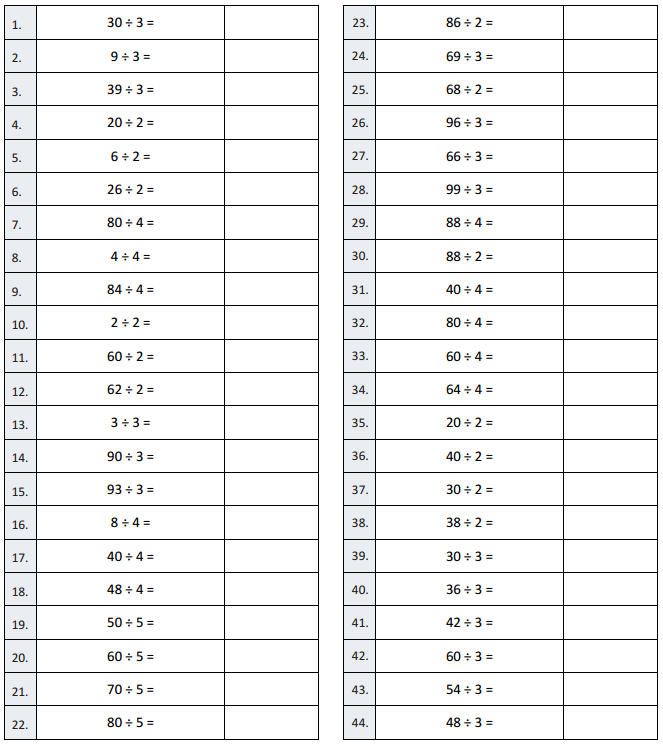
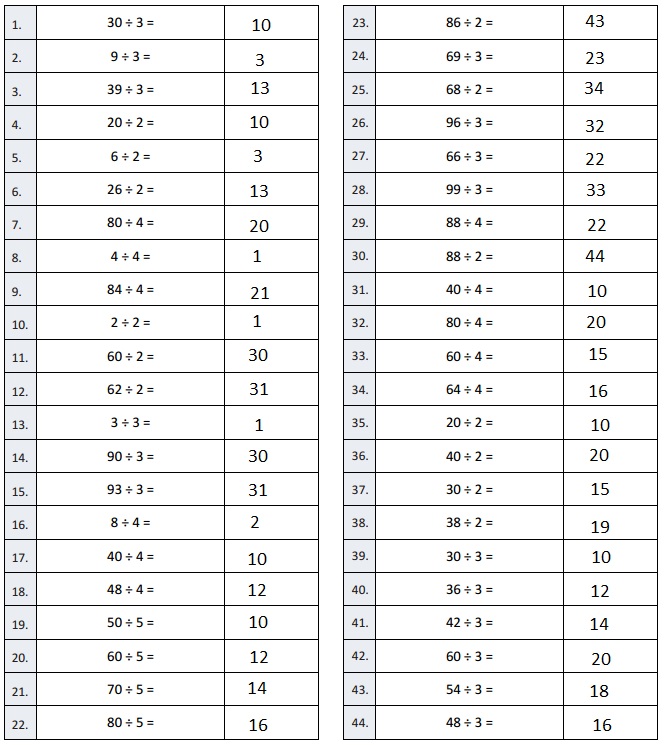
Question 1.
30 ÷ 3 =
Answer:
30 ÷ 3 = 10,
Explanation :
Given expression 30 ÷ 3 when 30 is divided by 3
we get 10, So quotient is 10 and remainder is 0 and
(3 X 10 = 30).
Question 2.
9 ÷ 3 =
Answer:
9 ÷ 3 = 3,
Explanation :
Given expression 9 ÷ 3 when 9 is divided by 3
we get 3, So quotient is 3 and remainder is 0 and
(3 X 3 = 9).
Question 3.
39 ÷ 3 =
Answer:
39 ÷ 3 = 13,
Explanation :
Given expression 39 ÷ 3 when 39 is divided by 3
we get 13, So quotient is 13 and remainder is 0 and
(3 X 13 = 39).
Question 4.
20 ÷ 2 =
Answer:
20 ÷ 2 = 10,
Explanation :
Given expression 20 ÷ 2 when 20 is divided by 2
we get 10, So quotient is 10 and remainder is 0 and
(2 X 10 = 20).
Question 5.
6 ÷ 2 =
Answer:
6 ÷ 2 = 3,
Explanation :
Given expression 6 ÷ 2 when 6 is divided by 2
we get 3, So quotient is 3 and remainder is 0 and
(2 X 3 = 6).
Question 6.
26 ÷ 2 =
Answer:
26 ÷ 2 = 13,
Explanation :
Given expression 26 ÷ 2 when 26 is divided by 2
we get 13, So quotient is 13 and remainder is 0 and
(2 X 13 = 26).
Question 7.
80 ÷ 4 =
Answer:
80 ÷ 4 = 20,
Explanation :
Given expression 80 ÷ 4 when 80 is divided by 4
we get 20, So quotient is 20 and remainder is 0 and
(4 X 20 = 80).
Question 8.
4 ÷ 4 =
Answer:
4 ÷ 4 = 1,
Explanation :
Given expression 4 ÷ 4 when 4 is divided by 4
we get 1, So quotient is 4 and remainder is 0 and
(4 X 1 = 4).
Question 9.
84 ÷ 4 =
Answer:
84 ÷ 4 = 21,
Explanation :
Given expression 84 ÷ 4 when 84 is divided by 4
we get 21, So quotient is 21 and remainder is 0 and
(4 X 21 = 84).
Question 10.
2 ÷ 2 =
Answer:
2 ÷ 2 = 1,
Explanation :
Given expression 2 ÷ 2 when 2 is divided by 2
we get 1, So quotient is 1 and remainder is 0 and
(2 X 1 = 2).
Question 11.
60 ÷ 2 =
Answer:
60 ÷ 2 = 30,
Explanation :
Given expression 60 ÷ 2 when 60 is divided by 2
we get 30, So quotient is 30 and remainder is 0 and
(2 X 30 = 60).
Question 12.
62 ÷ 2 =
Answer:
62 ÷ 2 = 31,
Explanation :
Given expression 62 ÷ 2 when 62 is divided by 2
we get 31, So quotient is 31 and remainder is 0 and
(2 X 31 = 62).
Question 13.
3 ÷ 3 =
Answer:
3 ÷ 3 = 1,
Explanation :
Given expression 3 ÷ 3 when 3 is divided by 3
we get 1, So quotient is 1 and remainder is 0 and
(3 X 1 = 3).
Question 14.
90 ÷ 3 =
Answer:
90 ÷ 3 = 30,
Explanation :
Given expression 90 ÷ 3 when 90 is divided by 3
we get 30, So quotient is 30 and remainder is 0 and
(3 X 30 = 90).
Question 15.
93 ÷ 3 =
Answer:
93 ÷ 3 = 31,
Explanation :
Given expression 93 ÷ 3 when 93 is divided by 3
we get 31, So quotient is 31 and remainder is 0 and
(3 X 31 = 93).
Question 16.
8 ÷ 4 =
Answer:
8 ÷ 4 = 2,
Explanation :
Given expression 8 ÷ 4 when 8 is divided by 4
we get 2, So quotient is 2 and remainder is 0 and
(4 X 2 = 8).
Question 17.
40 ÷ 4 =
Answer:
40 ÷ 4 = 10,
Explanation :
Given expression 40 ÷ 4 when 40 is divided by 4
we get 10, So quotient is 10 and remainder is 0 and
(4 X 10 = 40).
Question 18.
48 ÷ 4 =
Answer:
48 ÷ 4 = 12,
Explanation :
Given expression 48 ÷ 4 when 48 is divided by 4
we get 12, So quotient is 12 and remainder is 0 and
(4 X 12 = 48).
Question 19.
50 ÷ 5 =
Answer:
50 ÷ 5 = 10,
Explanation :
Given expression 50 ÷ 5 when 50 is divided by 5
we get 10, So quotient is 10 and remainder is 0 and
(5 X 10 = 50).
Question 20.
60 ÷ 5 =
Answer:
60 ÷ 5 = 12,
Explanation :
Given expression 60 ÷ 5 when 60 is divided by 5
we get 12, So quotient is and remainder is 0 and
(5 X 12 = 60).
Question 21.
70 ÷ 5 =
Answer:
70 ÷ 5 = 14,
Explanation :
Given expression 70 ÷ 5 when 70 is divided by 5
we get 14, So quotient is 14 and remainder is 0 and
(5 X 14 = 70).
Question 22.
80 ÷ 5 =
Answer:
80 ÷ 5 = 16,
Explanation :
Given expression 80 ÷ 5 when 80 is divided by 5
we get 16, So quotient is 16 and remainder is 0 and
(5 X 16 = 80).
Question 23.
86 ÷ 2 =
Answer:
86 ÷ 2 = 43,
Explanation :
Given expression 86 ÷ 2 when 86 is divided by 2
we get 43, So quotient is 43 and remainder is 0 and
(2 X 43 = 86).
Question 24.
69 ÷ 3 =
Answer:
69 ÷ 3 = 23,
Explanation :
Given expression 69 ÷ 3 when 69 is divided by 3
we get 23, So quotient is 23 and remainder is 0 and
(3 X 23 = 69).
Question 25.
68 ÷ 2 =
Answer:
68 ÷ 2 = 34,
Explanation :
Given expression 68 ÷ 2 when 68 is divided by 2
we get 34, So quotient is 34 and remainder is 0 and
(2 X 34 = 68).
Question 26.
96 ÷ 3 =
Answer:
96 ÷ 3 = 32,
Explanation :
Given expression 96 ÷ 3 when 96 is divided by 3
we get 32, So quotient is 32 and remainder is 0 and
(3 X 32 = 96).
Question 27.
66 ÷ 3 =
Answer:
66 ÷ 3 = 22,
Explanation :
Given expression 66 ÷ 3 when 66 is divided by 3
we get 22, So quotient is 22 and remainder is 0 and
(3 X 22 = 66).
Question 28.
99 ÷ 3 =
Answer:
99 ÷ 3 = 33,
Explanation :
Given expression 99 ÷ 3 when 99 is divided by 3
we get 33, So quotient is 33 and remainder is 0 and
(3 X 33 = 99).
Question 29.
88 ÷ 4 =
Answer:
88 ÷ 4 = 22,
Explanation :
Given expression 88 ÷ 4 when 88 is divided by 4
we get 22, So quotient is 22 and remainder is 0 and
(4 X 22 = 88).
Question 30.
88 ÷ 2 =
Answer:
88 ÷ 2 = 44,
Explanation :
Given expression 88 ÷ 2 when 88 is divided by 2
we get 44, So quotient is 44 and remainder is 0 and
(2 X 44 = 88).
Question 31.
40 ÷ 4 =
Answer:
40 ÷ 4 = 10,
Explanation :
Given expression 40 ÷ 10 when 40 is divided by 4
we get 10, So quotient is 10 and remainder is 0 and
(4 X 10 = 40).
Question 32.
80 ÷ 4 =
Answer:
80 ÷ 4 = 20,
Explanation :
Given expression 80 ÷ 4 when 80 is divided by 4
we get 20, So quotient is 20 and remainder is 0 and
(4 X 20 = 80).
Question 33.
60 ÷ 4 =
Answer:
60 ÷ 4 = 15,
Explanation :
Given expression 60 ÷ 4 when 60 is divided by 4
we get 15, So quotient is 15 and remainder is 0 and
(4 X 15 = 60).
Question 34.
64 ÷ 4 =
Answer:
64 ÷ 4 = 16,
Explanation :
Given expression 64 ÷ 4 when 64 is divided by 4
we get 16, So quotient is 16 and remainder is 0 and
(4 X 16 = 64).
Question 35.
20 ÷ 2 =
Answer:
20 ÷ 2 = 10,
Explanation :
Given expression 20 ÷ 2 when 20 is divided by 2
we get 10, So quotient is 10 and remainder is 0 and
(2 X 10 = 20).
Question 36.
40 ÷ 2 =
Answer:
40 ÷ 2 = 20,
Explanation :
Given expression 40 ÷ 2 when 40 is divided by 2
we get 20, So quotient is 20 and remainder is 0 and
(2 X 20 = 40).
Question 37.
30 ÷ 2 =
Answer:
30 ÷ 2 = 15,
Explanation :
Given expression 30 ÷ 2 when 30 is divided by 2
we get 15, So quotient is 15 and remainder is 0 and
(2 X 15 = 30).
Question 38.
38 ÷ 2 =
Answer:
38 ÷ 2 = 19,
Explanation :
Given expression 38 ÷ 2 when 38 is divided by 2
we get 19, So quotient is 19 and remainder is 0 and
(2 X 19 = 38).
Question 39.
30 ÷ 3 =
Answer:
30 ÷ 3 = 10,
Explanation :
Given expression 30 ÷ 3 when 30 is divided by 3
we get 10, So quotient is 10 and remainder is 0 and
(3 X 10 = 30).
Question 40.
36 ÷ 3 =
Answer:
36 ÷ 3 = 12,
Explanation :
Given expression 36 ÷ 3 when 36 is divided by 3
we get 12, So quotient is 12 and remainder is 0 and
(3 X 12 = 36).
Question 41.
42 ÷ 3 =
Answer:
42 ÷ 3 = 14,
Explanation :
Given expression 42 ÷ 3 when 42 is divided by 3
we get 14, So quotient is 14 and remainder is 0 and
(3 X 14 = 42).
Question 42.
60 ÷ 3 =
Answer:
60 ÷ 3 = 20,
Explanation :
Given expression 60 ÷ 3 when 60 is divided by 3
we get 20, So quotient is 20 and remainder is 0 and
(3 X 20 = 60).
Question 43.
54 ÷ 3 =
Answer:
54 ÷ 3 = 18,
Explanation :
Given expression 54 ÷ 3 when 54 is divided by 3
we get 18, So quotient is 18 and remainder is 0 and
(3 X 18 = 54).
Question 44.
48 ÷ 3 =
Answer:
48 ÷ 3 = 16,
Explanation :
Given expression 48 ÷ 3 when 48 is divided by 3
we get 16, So quotient is 16 and remainder is 0 and
(3 X 16 = 48).
Eureka Math Grade 4 Module 3 Lesson 19 Problem Set Answer Key
Question 1.
When you divide 94 by 3, there is a remainder of 1.
Model this problem with place value disks. In the place
value disk model, how did you show the remainder?
Answer:
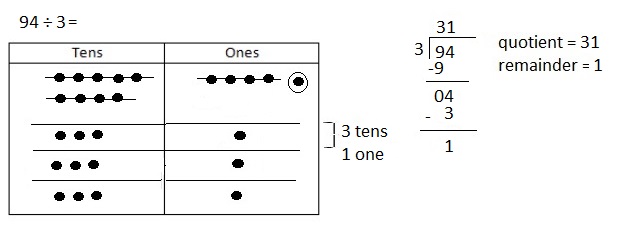
I showed my remainder by circling the remaining one
in the ones place.
Explanation:
When we divide 94 by 3, there is a remainder of 1.
Modeled the problem with place value disks. In the place
value disk model, showed the remainder by circling the
remaining one in the ones place.
Question 2.
Cayman says that 94 ÷ 3 is 30 with a remainder of 4.
He reasons this is correct because (3 × 30) + 4 = 94.
What mistake has Cayman made? Explain how he can
correct his work.
Answer:
Cayman mistake is that his remainder is greater than
his divisor means he can divide more.
Instead of 30 groups he can make 31 groups.
Explanation:
Given Cayman says that 94 ÷ 3 is 30 with a remainder of 4.
He reasons this is correct because (3 × 30) + 4 = 94.
Instead of 30 groups he can make 31 groups,
94 ÷ 3 when 94 is divided by 3
we get 31 as quotient and remainder is 1.
Question 3.
The place value disk model is showing 72 ÷ 3.
Complete the model. Explain what happens to the
1 ten that is remaining in the tens column.
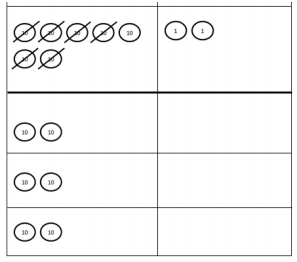
Answer:
The 1 ten remaining gets decomposed into
10 ones column,
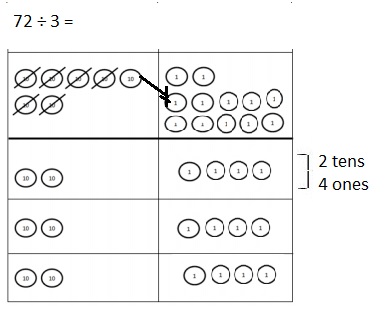
Explanation:
Given the place value disk model is showing 72 ÷ 3.
Completed the model. Explained what happens to the
1 ten that is remaining in the tens column gets decomposed
into10 ones column as shown above.
Question 4.
Two friends evenly share 56 dollars.
a. They have 5 ten-dollar bills and 6 one-dollar bills.
Draw a picture to show how the bills will be shared.
Will they have to make change at any stage?
Answer:
Yes, they will have to make change for 1 dollar bill.
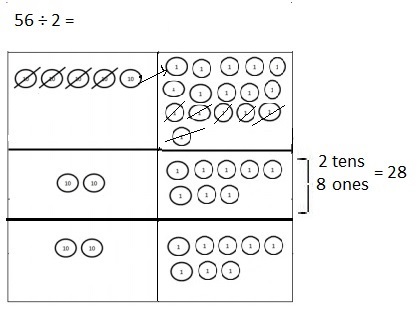
Explanation:
In order to share its the ten dollar bill needs to be decomposed
into one dollar bills.
Drawn a picture to show how the bills will be shared
and have to make changes as shown above.
b. Explain how they share the money evenly.
Answer:
Each friend gets 2 ten dollar bills and 8 one dollar bills,
Explanation:
Given two friends evenly share 56 dollars,
they have 5 ten-dollar bills and 6 one-dollar bills,
they shared the money evenly as 2 ten dollar bills and
8 one dollar bills.
Question 5.
Imagine you are filming a video explaining the
blem 45 ÷ 3 to new fourth graders. Create a script to
explain how you can keep dividing after getting a
remainder of 1 ten in the first step.
Answer:
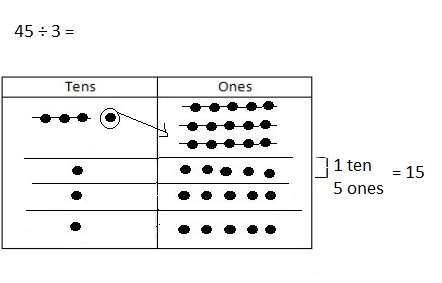
Explanation:
Watch as I solve 45 ÷ 3 using a place value chart.
First I divide my tens, Each of the 3 groups can equally
have 1 ten. There is 1 ten remaining, We can continue
dividing by decomposing the 1 ten into 10 ones. Watch as
I show this on my chart. Now I have 15 ones that can be
equally distributed into our 3 groups. Each group will get
5 ones. Now we can see that 45 ÷ 3 is 1 ten 5 ones or 15.
Eureka Math Grade 4 Module 3 Lesson 19 Exit Ticket Answer Key
Question 1.
Molly’s photo album has a total of 97 pictures.
Each page of the album holds 6 pictures.
How many pages can Molly fill? Will there be any
pictures left? If so, how many? Use place value disks to solve.
Answer:
Molly can fill 16 pages,
Yes, there will be 1 picture left,
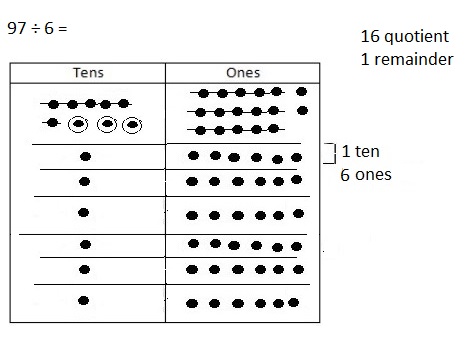
Explanation:
Given Molly’s photo album has a total of 97 pictures.
Each page of the album holds 6 pictures, So number of
pages can Molly fill are 97 ÷ 6 = 16 quotient and 1 remainder
means Molly can fill 16 pages and there will be 1 picture left
as shown above using place value disks.
Question 2.
Marti’s photo album has a total of 45 pictures.
Each page holds 4 pictures. She said she can only
fill 10 pages completely. Do you agree? Explain why or why not.
Answer:
No, I don’t agree, why because she can fill 11 pages completly
with 1 picture left,
Explanation:
Marti’s photo album has a total of 45 pictures.
Each page holds 4 pictures. She said she can only
fill 10 pages completely, I don’t agree because
if we divide 45 pictures by 4 we get 11 pages but she
said she can only fill 10 pages completely so disagree.
Eureka Math Grade 4 Module 3 Lesson 19 Homework Answer Key
Question 1.
When you divide 86 by 4, there is a remainder of 2.
Model this problem with place value disks. In the
place value disk model, how can you see that there is a remainder?
Answer:
I showed my remainder by circling the remaining two
in the ones place,
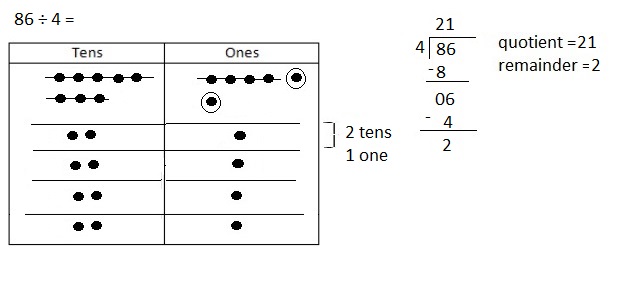
Explanation:
When we divide 86 by 4, there is a remainder of 2.
Modeled the problem with place value disks. In the place
value disk model, showed the remainder by circling the
remaining two in the ones place.
Question 2.
Francine says that 86 ÷ 4 is 20 with a remainder of 6.
She reasons this is correct because (4 × 20) + 6 = 86.
What mistake has Francine made? Explain how she can
correct her work.
Answer:
Francine mistake is that her remainder is greater than
his divisor means he can divide more.
Instead of 20 groups he can make 21 groups,
Explanation:
Given Francine says that 86 ÷ 4 is 20 with a remainder of 6.
Her reasons this is correct because (4 X 20) + 6 = 86.
Instead of 20 groups he can make 21 groups,
86 ÷ 4 when 86 is divided by 4
we get 21 as quotient and remainder is 2.
Question 3.
The place value disk model is showing 67 ÷ 4.
Complete the model. Explain what happens to
the 2 tens that are remaining in the tens column.
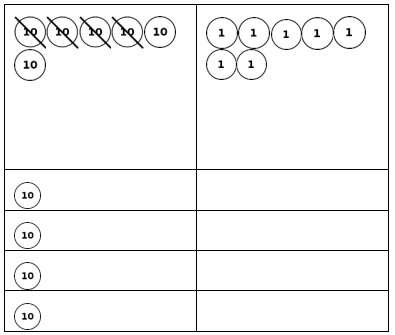
Answer:
The 2 tens remaining gets decomposed into
20 ones column,
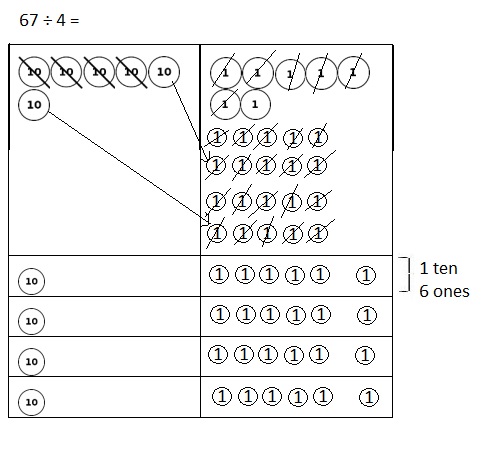
Explanation:
Given the place value disk model is showing 67 ÷ 4.
Completed the model. Explained what happens to the
2 tens that is remaining in the tens column gets decomposed
into 20 ones column as shown above.
Question 4.
Two friends share 76 blueberries.
a. To count the blueberries, they put them into small
bowls of 10 blueberries. Draw a picture to show how the
blueberries can be shared equally. Will they have to split
apart any of the bowls of 10 blueberries when they share them?
Answer:
Yes, they will have to make change for 1 bowl,
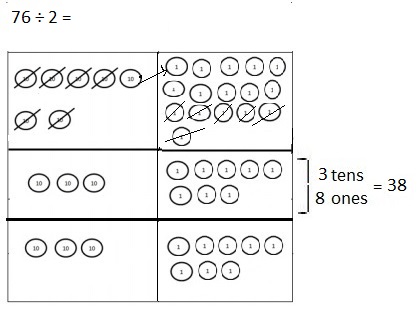
Explanation:
In order to share it the 10 blueberries needs to be decomposed
into ones blueberries.
Drawn a picture to show how the blueberries will be shared
and have to make changes as shown above.
b. Explain how the friends can share the blueberries fairly.
Answer:
Each friend gets 3 ten blueberries and 8 blueberries,
Explanation:
Given two friends can share 76 blueberries,
they have 3 ten-blueberries and 8 one-blueberries,
Each friend shared 3 ten blueberries and 8 blueberries.
Question 5.
Imagine you are drawing a comic strip showing how to
solve the problem 72 ÷ 4 to new fourth graders. Create a
script to explain how you can keep dividing after getting a
remainder of 3 tens in the first step.
Answer:
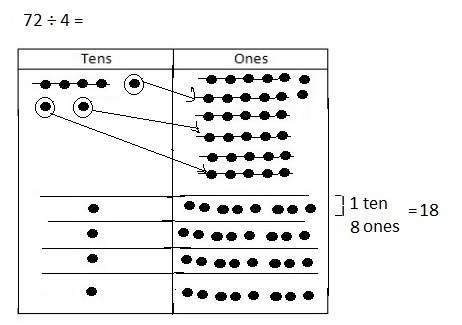
Explanation:
Created a script as I solve 72 ÷ 4 using a place value chart.
First I divide my tens into 4 groups I get 4 tens into 1 group,
There are 3 tens remaining, We can continue
dividing by decomposing the tens into 30 ones. Watch as
I show this on my chart. Now I have 32 ones that can be
equally distributed into our 4 groups. Each group will get
8 ones. Now we can see that 72 ÷ 4 is 1 ten 8 ones or 18.
